Wild Atlantic adventures on Loop Head / Aventures atlantiques à Loop Head
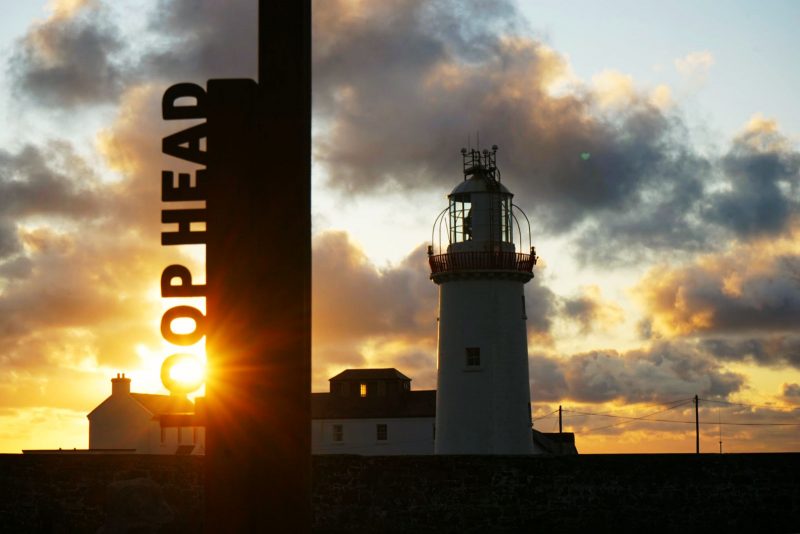
Four Acorns, plus my 16 year old niece from France, packed their wetsuits, raingear and wellies to go wild about the Loop Head Peninsula, Co Clare.
After an unforgettable October bank holiday weekend in West Cork last year, location of my first ever wild Atlantic swim and of a truly magical starlight kayaking experience, this time we headed off to the “other side of Ireland”, as my niece put it, to Loop Head, in West Clare.
Les quatre graines de chêne, ainsi que ma nièce de 16 ans, ont mis dans leurs bagages leurs imperméables, leurs bottes en caoutchouc et leurs combinaisons de plongée, pour partir à la découverte de la péninsule de Loop Head, Co Clare.
Après notre un weekend de fin octobre dans le comté de Cork l’an dernier, théâtre de ma première baignade sauvage dans l’Atlantique et d’une escapade en kayak sous les les étoiles, cette fois nous sommes allés de “l’autre côté de l’Irlande”, comme dit ma nièce.
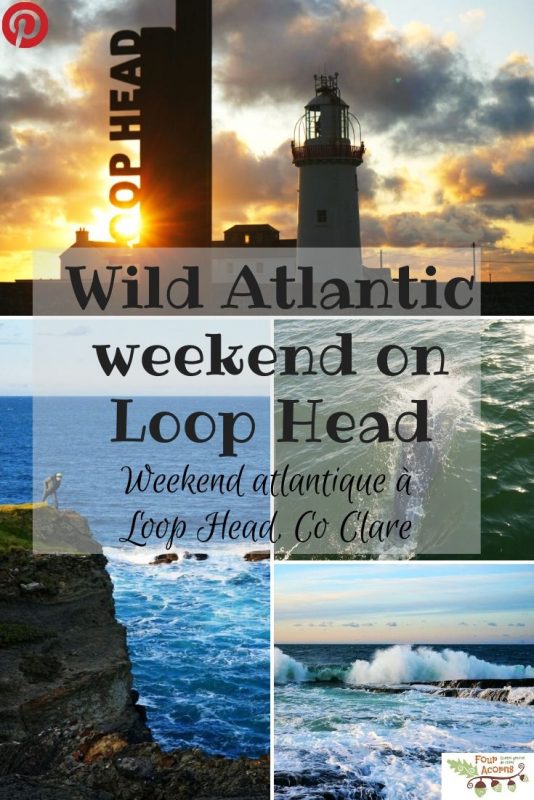
Loop Head is a slender finger of rocky land jutting out into the ocean, along Ireland’s much-famed Wild Atlantic Way.
To the north, the mighty Atlantic waves have relentlessly sculpted the sandstone into a dizzying array of sea stacks, sea cliffs and sea arches. To the south, the gentler tidal currents of the Shannon Estuary have created sand beaches and mud flats. In-between the two shores, the treeless peninsula rolls out a checkered green carpet of small fields crisscrossed by low hedgerows, under immense open skies.
Loop Head est une mince bande de terre s’avançant dans l’océan, le long du fameux Wild Atlantic Way d’Irlande.
Au nord, les déferlantes de l’Atlantique ont sculpté le grès du littoral en un ensemble vertigineux d’éperons, d’arches et de falaises côtières. Au sud, les courants et les marées de l’estuaire de la Shannon ont façonné des plages de sable et des vasières. Entre les deux côtes, la péninsule se déroule, dépourvue d’arbres, en un tapis vert de champs délimités par des haies basses, sous un ciel immense.
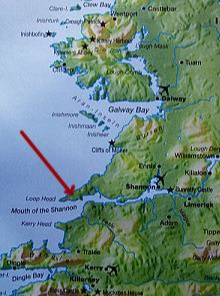
At the very tip of the peninsula, Loop Head Lighthouse is Clare’s westernmost point, and the last stop before America.
A l’extrémité de la péninsule, le phare de Loop Head marque le point le plus occidental du comté de Clare et le dernier arrêt avec l’Amérique.
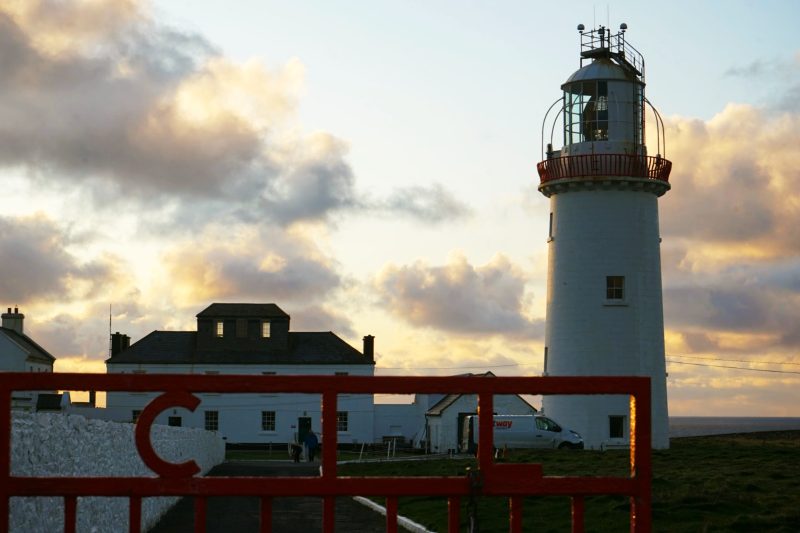
The area had first come to my attention when it was voted the Best Place to Holiday in Ireland by The Irish Times in 2013.
Then I read Ireland’s Adventure Bucket List, by Helen Fairbairn, which lists snorkelling in Kilkee’s tidal pools as an adventure suitable for the whole family – read all about our coastal adventures at the Pollock Holes here.
This enticed me to book a short stay on the windswept peninsula – 3 nights of self-catering at Anvil Farm for the October bank holiday weekend.
For my niece, it was a holiday within the holiday!
La région avait retenu mon attention quand, en 2013, elle a été élue meilleure destination de vacances en Irlande par le quotidien The Irish Times.
Puis un livre, intitulé Ireland’s Adventure Bucket List, de Helen Fairbairn, mentionne la plongée au tuba dans les bassins de marée de Kilkee parmi les aventures adaptées à toute la famille. Découvrez nos exploits dans les eaux des Pollock Holes ici.
C’est ce qui me décida à réserver un séjour sur la péninsule battue par les vents : 3 nuits en location à Anvil Farm pour le weekend de trois jours de la fin octobre (en Irlande, le dernier lundi d’octobre est un jour férié).
Des vacances pendants les vacances pour ma nièce venue de France !
Contents / Sommaire
1. Loop Head Lighthouse
Arriving on the Loop Head peninsula on the Saturday mid-afternoon, we quickly checked in at our accommodation, before heading out again. There was some exploring to be done before sunset.
From our holiday home in the rural townland of Kilbaha, we drove to the tip of the peninsula, all the way to Loop Head Lighthouse.
Luckily, the last guided tour of the day was about to start. Seeking shelter from the ceaseless winds, we took a look at the permanent exhibition in the lightkeeper’s cottage, before climbing up the tower with our guide.
As one of the Great Lighthouses of Ireland, it can be visited. Besides, one of the lightkeeper’s cottages has been restored as holiday accommodation by the Irish Landmark Trust.
Le phare de Loop Head
En arrivant sur la péninsule de Loop Head le samedi après-midi, nous avons vite déposé nos bagages à la maison de vacances, avant de ressortir sans tarder. Il y avait des choses à découvrir avant le coucher du soleil.
De notre location aux abords du hameau de Kilbaha, nous sommes allés jusqu’au bout de la péninsule, là où se dresse le phare de Loop Head.
Par chance, la dernière visite guidée de la journée allait démarrer. Pour s’abriter du vent, nous avons jeté un coup d’œil à l’exposition permanente dans l’ancien logis du gardien de phare, avant de gravir les marches en pierre de la tour avec notre guide.
Comme tous les Great Lighthouses of Ireland, Loop Head se visite. Un des cottages des gardiens de phare a également été restauré pour l’accueil des touristes par l’Irish Landmark Trust.
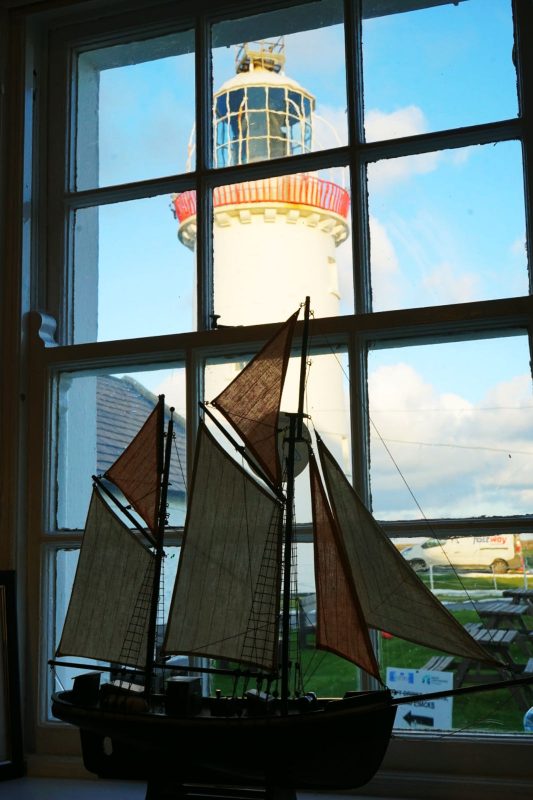
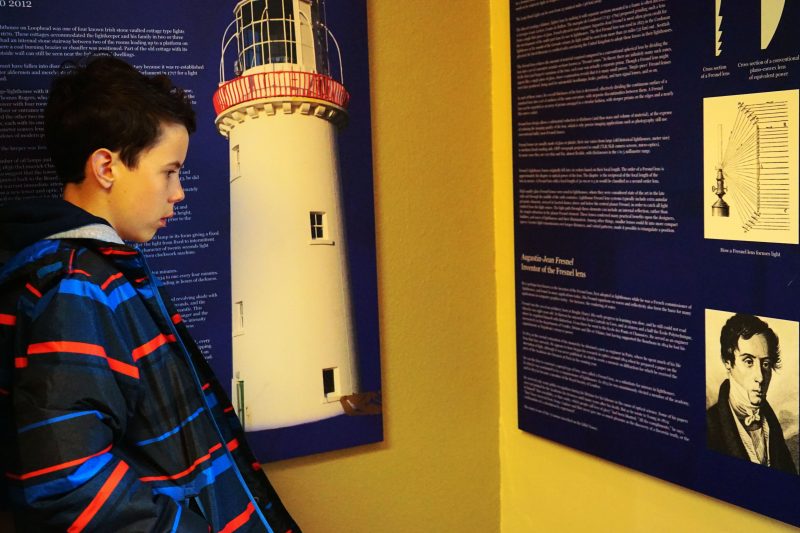
Jedi reads about French physicist Augustin-Jean Fresnel, who developed the eponymous lens for lighthouses /
Jedi lit un panneau consacré au physicien français Augustin-Jean Fresnel (1788-1827), qui inventa la lentille du même nom pour les lanternes de phare.
After visiting the lighthouses at Hook Head, Co Wexford, Mizen Head, Co Cork, and St. John’s Point, Co Donegal, Loop Head looked reassuringly familiar, yet as fascinating as ever.
There has been a lighthouse at Loop Head since 1670. The current 23-metre-high tower was built in 1854 and converted to electrical operation in 1971, to become fully automated 20 years later.
Après avoir visité les phares de Hook Head, Co Wexford, Mizen Head, Co Cork, et St John’s Point, Co Donegal, Loop Head parut étrangement familier, et tout aussi fascinant que ses semblables.
Le premier phare de Loop Head remonte à 1670. La tour actuelle de 23 mètres de haut, érigée en 1854, passa à l’alimentation électrique en 1971. Vingt ans plus tard, le phare fut automatisé.
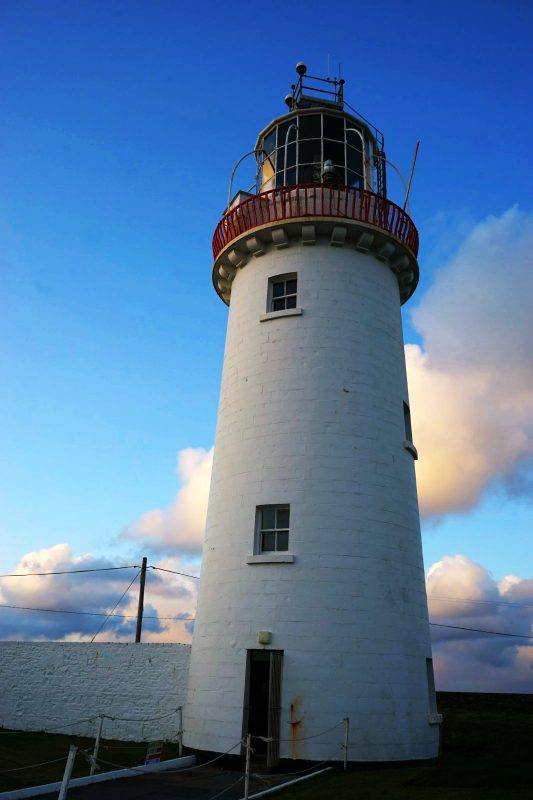
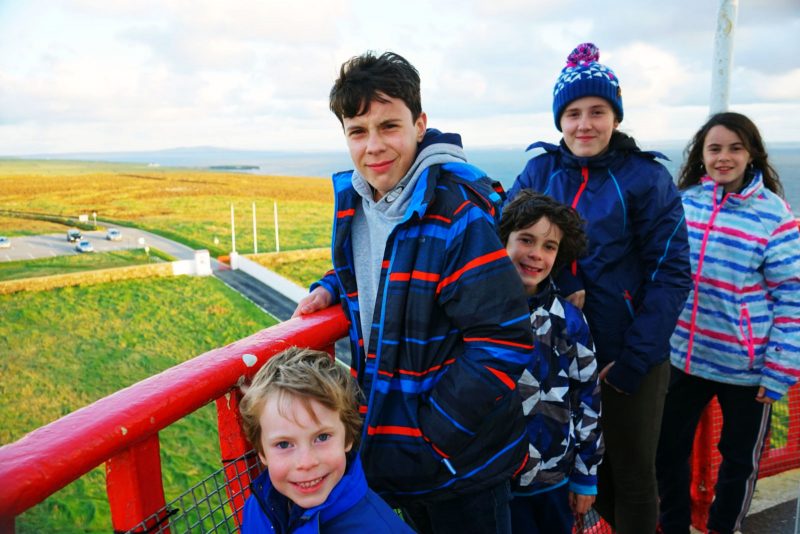
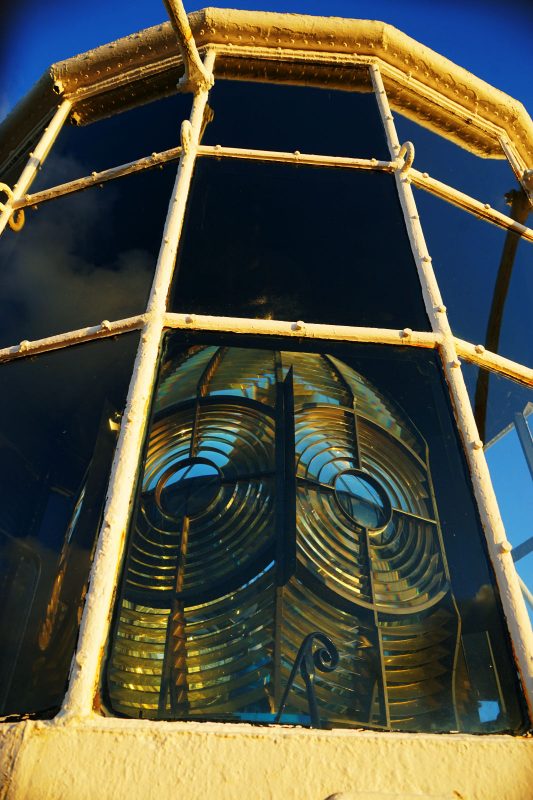
Fresnel lens at Loop Head Lighthouse / Lentille Fresnel au phare de Loop Head.
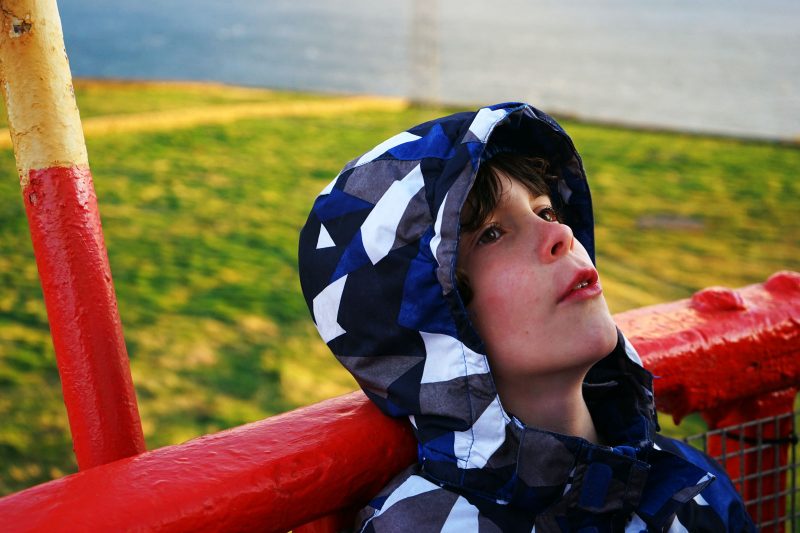
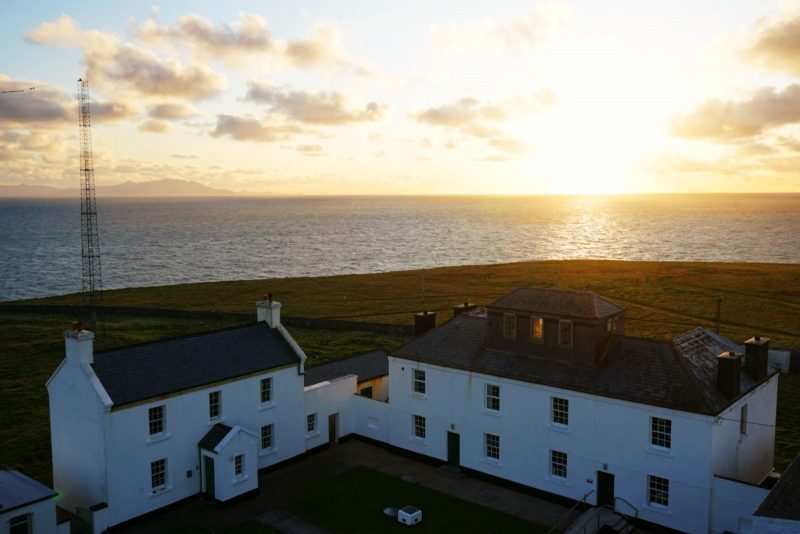
The lightkeeper’s cottage, restored as holiday accommodation by the Irish Landmark Trust /
Le cottage du gardien de phare, sur la gauche, a été restauré en location de vacances.
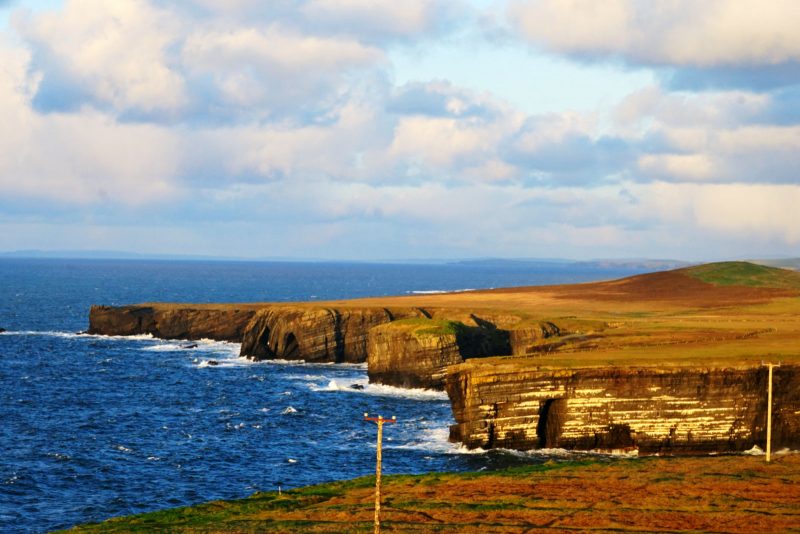
Loop Head’s jagged coastline is constantly battered by the ferocious Atlantic /
Le littoral tourmenté de Loop Head est sans cesse battu par les vagues de l’Atlantique.
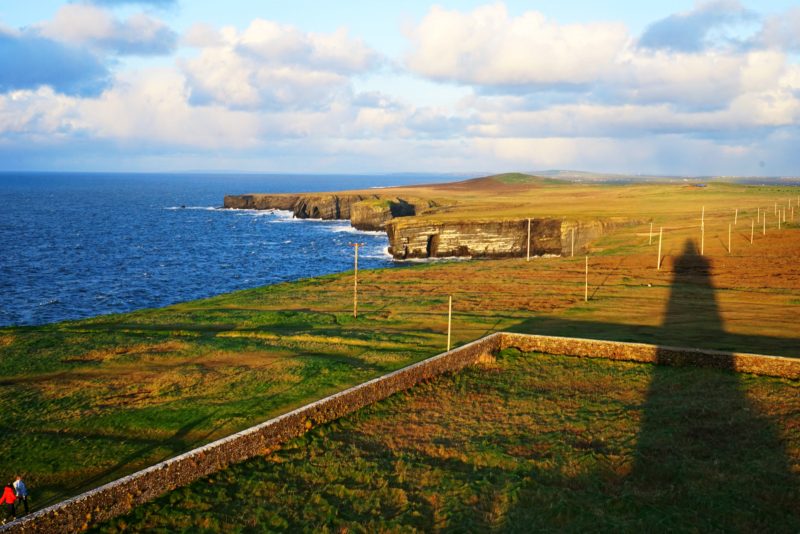
Following in the footsteps of other visitors to the lighthouse, we then ventured on a blowy, mucky walk to the very tip of the Loop Head peninsula.
Jumping between patches of soggy ground and staying away from the precipitous cliff-edge, we managed to miss the World War II EIRE marking, which signalled to Allied and German pilots that they were flying over neutral territory. (There is a similar one at the northernmost point in Ireland, Malin Head, Co Donegal – see more here.)
But watching the sun set over the ocean and listening to the constant roar of the waves crashing on the rocks 50 metres below our feet more than made up for it.
The elongated sea stack adjacent to the headland may have given Loop Head its name, a mistranslation of Ceann Léime, “Leap Head” in Irish. Mythical Celtic hero Cúchulainn is said to have jumped onto the sea stack to escape the attentions of a witch.
Emboîtant le pas à d’autres visiteurs du phare de Loop Head, nous avons poursuivi à pied jusqu’à l’extrémité de la péninsule – une balade décoiffante et boueuse !
Sautant entre les pans de sol détrempés et restant éloignés du bord de la falaise à pic, nous avons réussi à manquer l’inscription EIRE de la Seconde Guerre mondiale, qui indiquait aux pilotes alliés et allemands qu’ils survolaient un territoire neutre. (Il y a une inscription similaire au point le plus septentrional d’Irlande, Malin Head, Co Donegal – voyez ici.)
Mais de regarder le soleil se coucher sur l’océan tout en écoutant le grondement constant des vagues s’écrasant sur les rochers, à 50 mètres sous nos pieds, rattrapa largement ce manquement.
L’éperon marin adjacent à la péninsule a probablement donné son nom à Loop Head, une erreur de traduction du gaëlique Ceann Léime, qui signifie “pointe du saut”. A en croire la légende, le héros celtique Cúchulainn aurait bondi sur l’éperon pour échapper aux avances d’une sorcière.
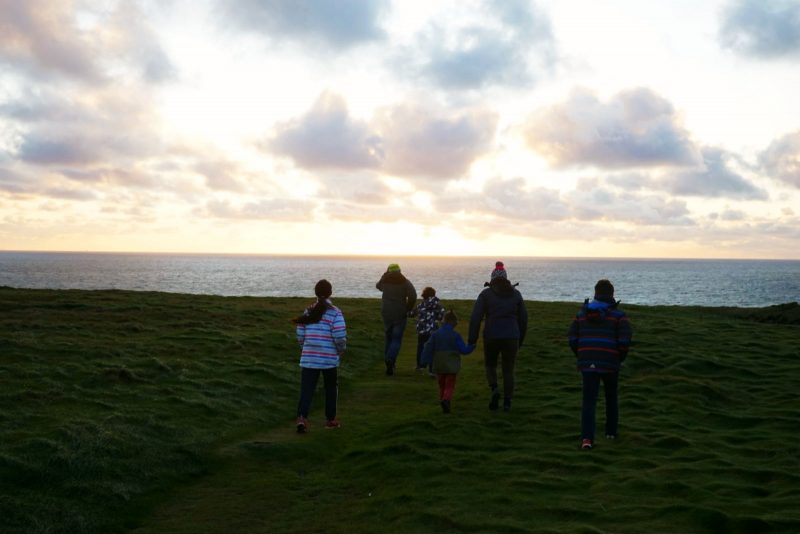
Going on a windy walk to the very tip of Loop Head / Balade décoiffante à la pointe de Loop Head.
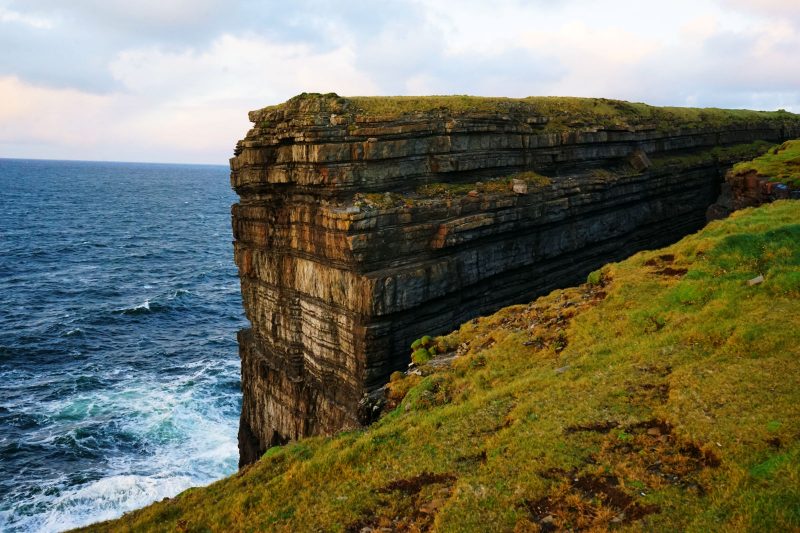
The adjacent sea stack is sometimes called Diarmuid and Gráinne’s Rock / L’éperon marin sur lequel Cúchulainn aurait sauté.
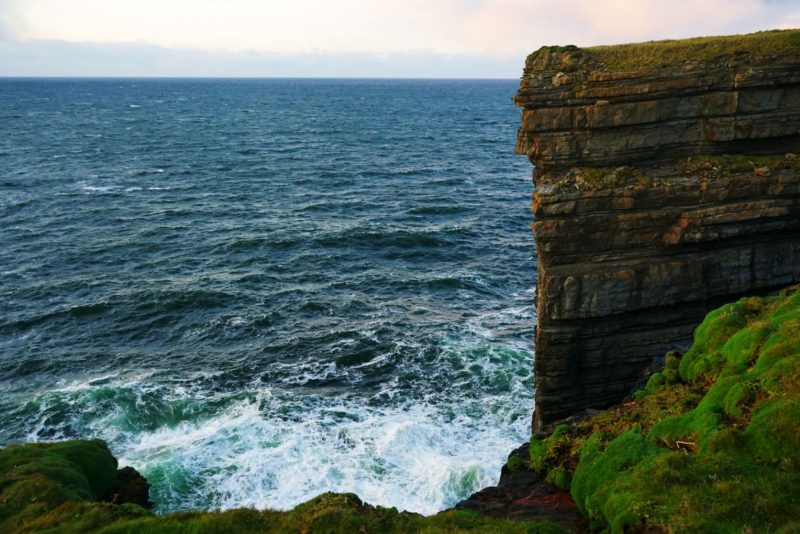
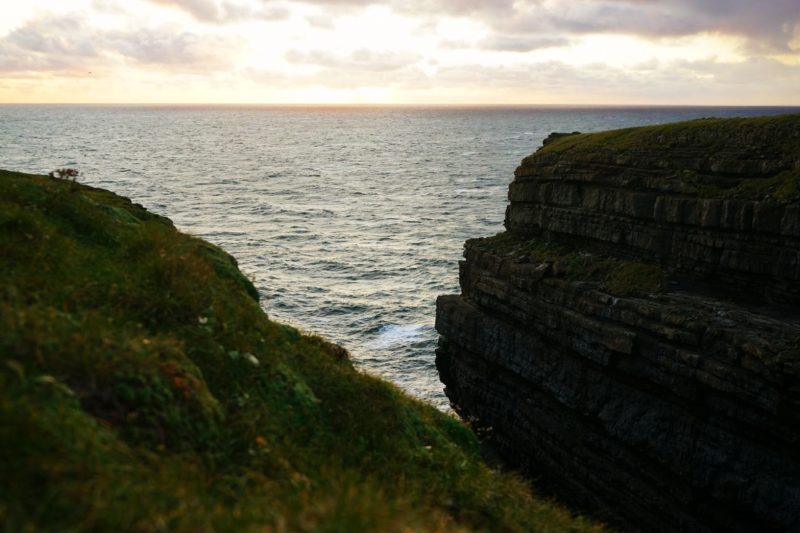
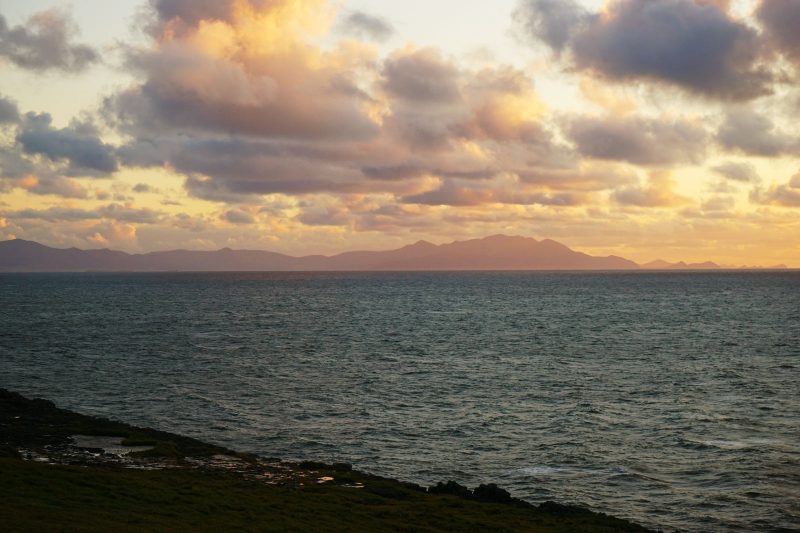
Watching the sunset over the mountains of Kerry Head / Coucher de soleil sur les monts de Kerry.
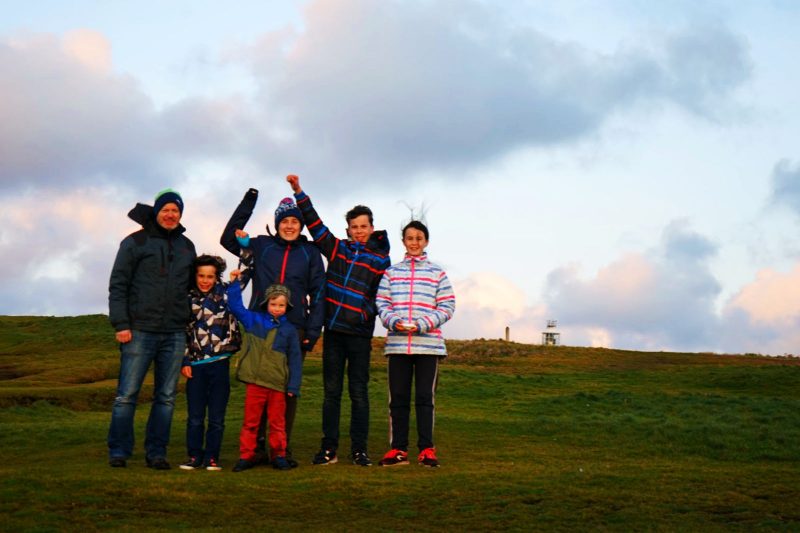
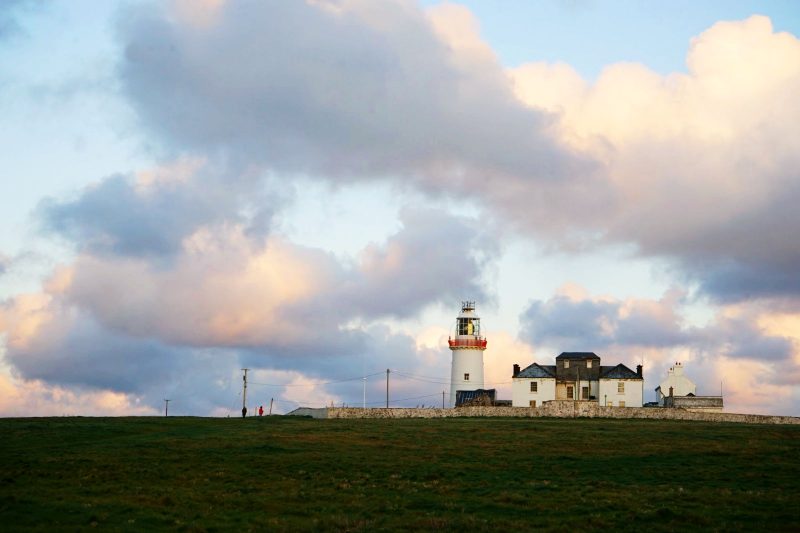
When we reached the car, the lantern on the lighthouse was yet to switch on for the night – it flashes 4 times every 20 seconds.
But it was time to get back to our holiday home.
2. The Bridges of Ross
Only the allure of “quickly checking out” another of the area’s landmarks proved irresistible! A few minutes’ drive from Loop Head Lighthouse and within walking distance from our accommodation, we took a sharp turn to the left, to reach the Bridges of Ross.
In the twilight, we followed the well-trodden footpath, our eyes peeled to try and spot the last remaining “bridge” – of the three natural sea arches sculpted by coastal erosion, two collapsed well over a century ago.
We only made it to the top of the first rocky promontory but it was enough to get a humbling sense of the ferocious might of the Atlantic Ocean. On this stretch of the Cliff Coast ceaselessly gnawed, gouged and scoured by powerful waves, on-shore winds brought up showers of sea foam up the cliff face – something the acorns welcomed with shrieks of delight, like the first snow of the season.
Every so often, the rock beneath our feet moaned thunderously at the unrelenting onslaught of the crashing waves – a pained rumble arising from unfathomable depths.
A notre retour à la voiture, la lanterne du phare ne s’était pas encore allumée pour la nuit. Elle s’éclaire 4 fois toutes les 20 secondes.
Mais il était temps de rentrer à notre maison de vacances.
Les ponts de Ross
Seulement voilà, l’attrait d’un petit détour “juste pour jeter un coup d’œil” à un autre haut lieu de Loop Head s’avéra irrésistible ! A 2 kilomètres du phare de Loop Head et à quelques minutes à pied de notre location, nous avons donc pris à gauche pour les ponts de Ross.
Dans la pénombre, nous avons emprunté le sentier bien marqué, équarquillant les yeux pour essayer de repérer le dernier “pont” encore debout : des trois arches sculptées par la mer, deux se sont effondrées il y a plus d’un siècle.
Nous ne sommes pas allés plus loin que le premier promontoire rocheux, mais ce fut suffisant pour prendre conscience de la puissance rageuse de l’océan Atlantique. Sur ce bout de littoral sans cesse creusé, rongé et grignoté par les vagues, les vents marins faisaient remonter des averses d’écume sur la paroi de la falaise, que les graines de chêne acueillaient avec des cris de joie, comme la première neige de la saison.
De temps à autre, le rocher sous nos pieds émettait un grondement sourd face à l’assaut implacable des vagues. Comme un râle de douleur remonté de profondeurs insondables.
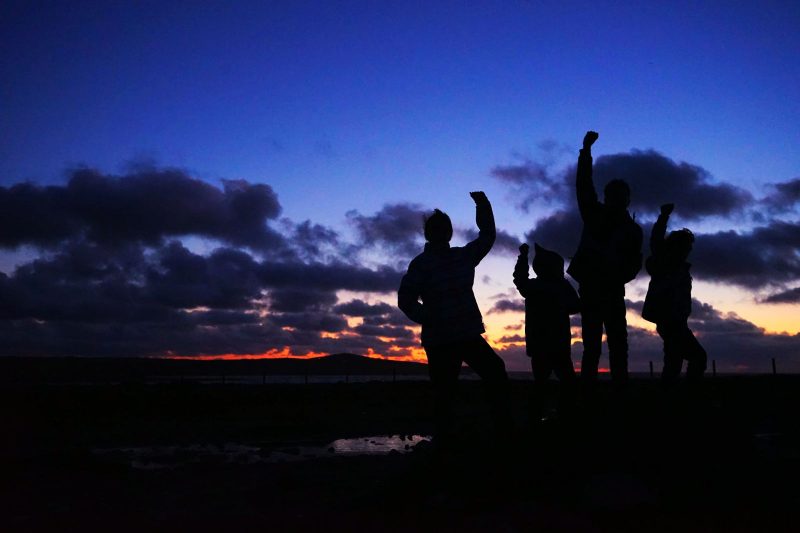
The acorns and P were so enthralled by the Bridges of Ross that we had to return. We went back on the Monday, our third day at Loop Head, after a delightful lunch at The Long Dock, in Carrigaholt.
With just over an hour of daylight left before dusk, we set off to explore the Bridges of Ross.
The acorns and P wanted to resume their imaginary battle with sea foam, but there was none this time. Nevermind. In the glorious light of the setting sun, we walked further, to the last remaining bridge of Ross.
Les graines de chêne et P s’amusèrent tellement aux ponts de Ross qu’il fallut y retourner. Ce que nous avons fait le lundi, notre troisième jour à Loop Head, après un repas délicieux au pub The Long Dock, à Carrigaholt.
Avec juste une heure de lumière avant le crépuscule, nous sommes partis à la découverte des ponts de Ross.
Les graines de chêne et P voulaient reprendre leur bataille imaginaire contre l’écume, mais il n’y en avait pas. Peu importe. Dans la lumière glorieuse du soleil couchant, nous sommes allés plus loin, jusqu’à dernier pont de Ross encore debout.
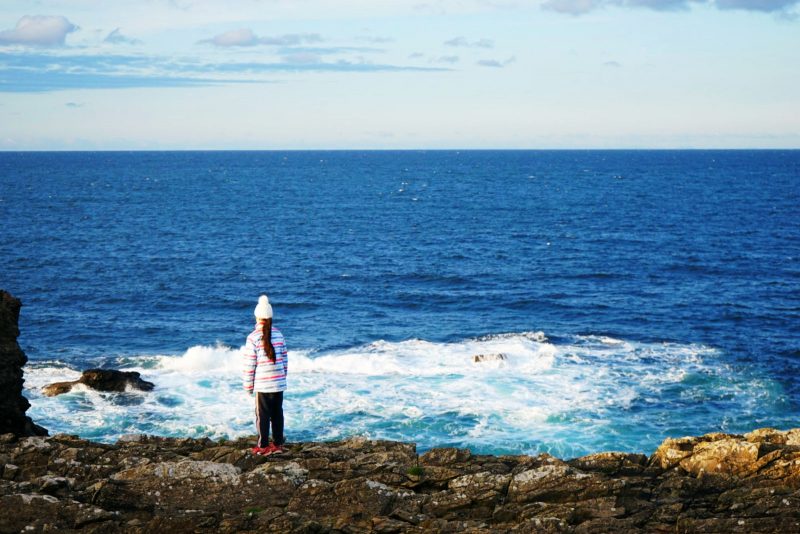
No sea foam this time / Pas d’écume cette fois.
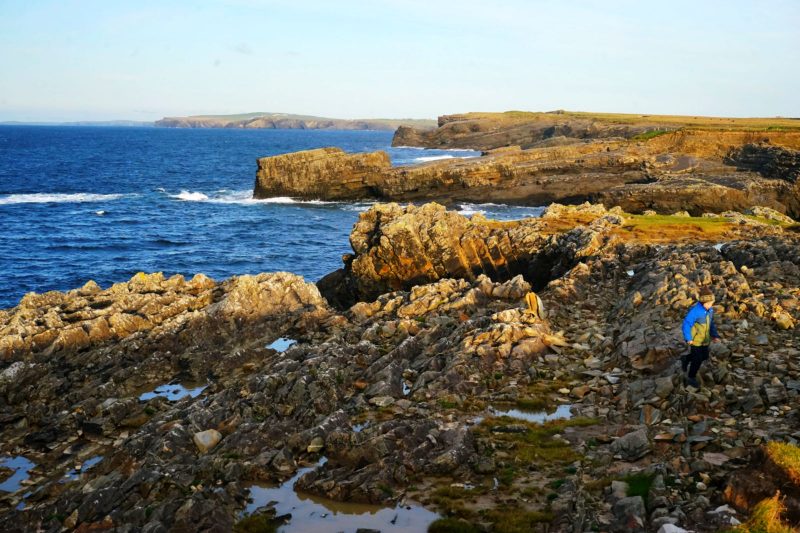
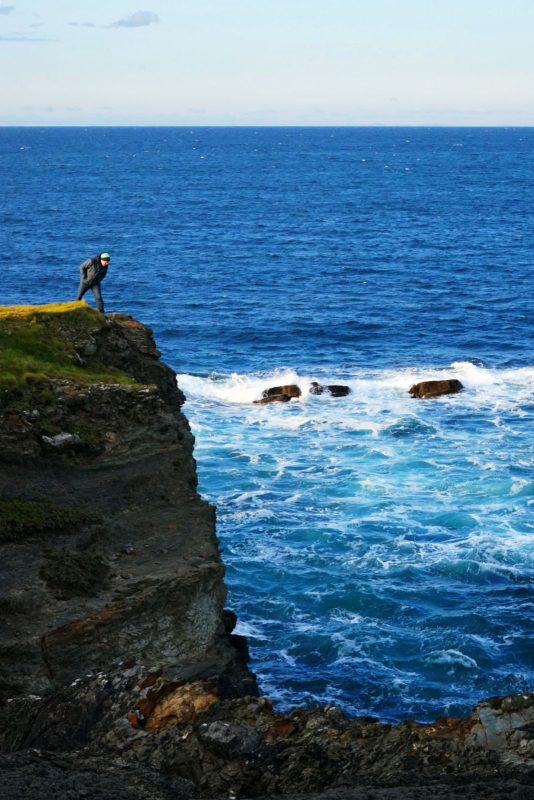
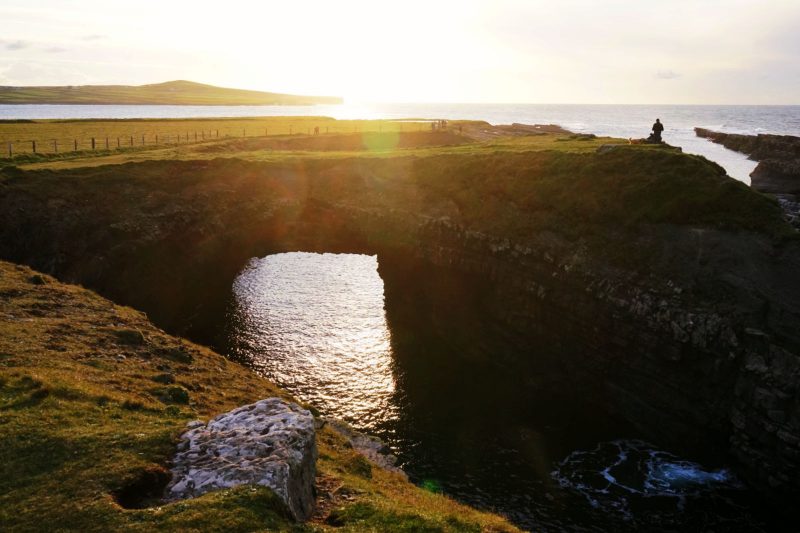
The last of the Bridges of Ross still standing / Le dernier pont de Ross encore debout.
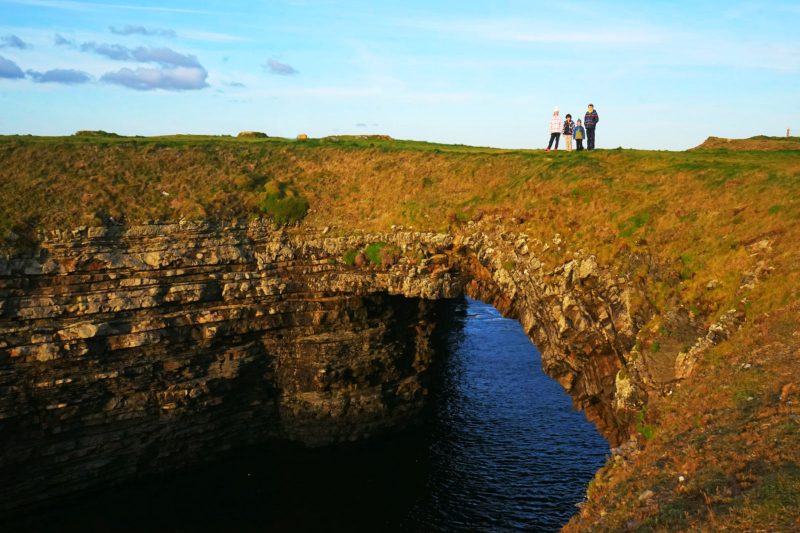
With the obligatory pictures taken on this monumental sea arch, the real exploring began.
Over large boulders we climbed.
Over deep fissures and miniature craters we stepped.
Over gigantic sloping platforms and rough sea walls we walked and ran.
The acorns and P even managed a short game of hide-and-seek among the rocks.
Une fois les photos de rigueur prises sur l’arche monumentale, les choses sérieuses purent commencer.
D’énormes rochers nous avons escaladé.
Des fissures profondes et des cratères miniatures nous avons franchi.
De vastes plateaux et des digues naturelles nous avons parcouru.
Les graines de chêne et P ont même fait une brève partie de cache-cache sur les rochers.
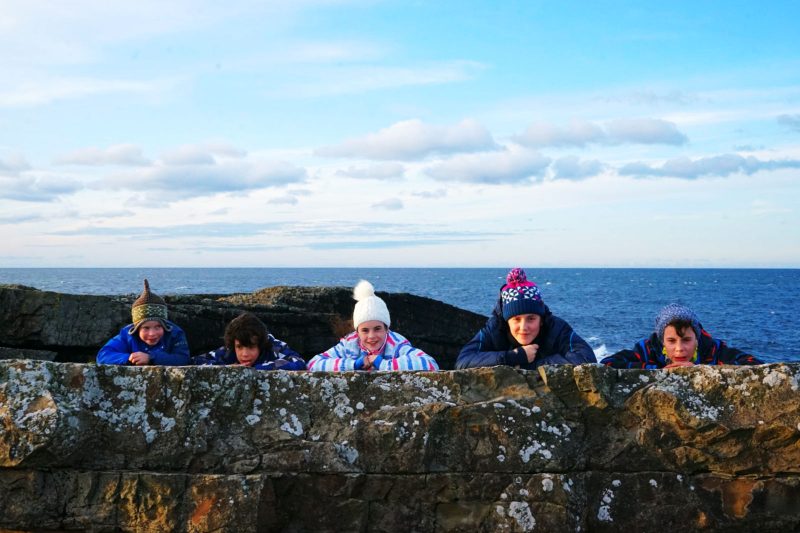
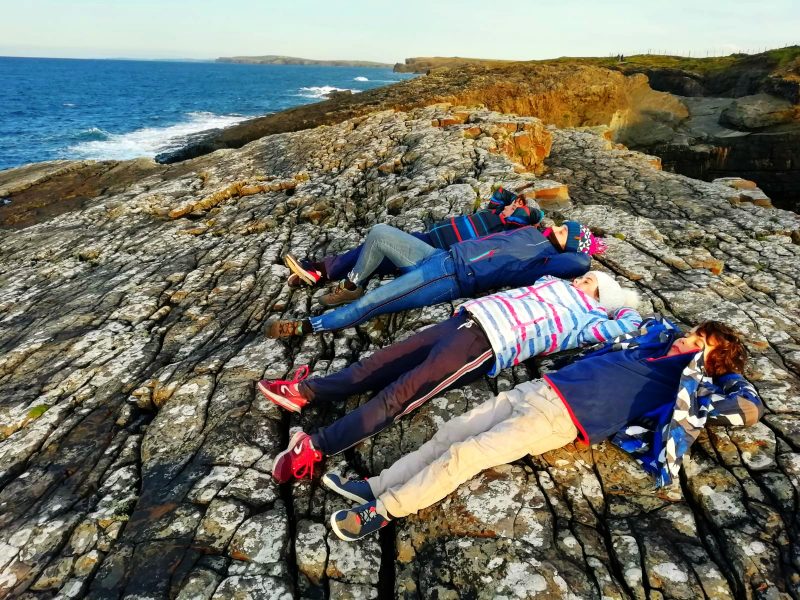
Sunbathing the Irish way / Bronzette à l’irlandaise.
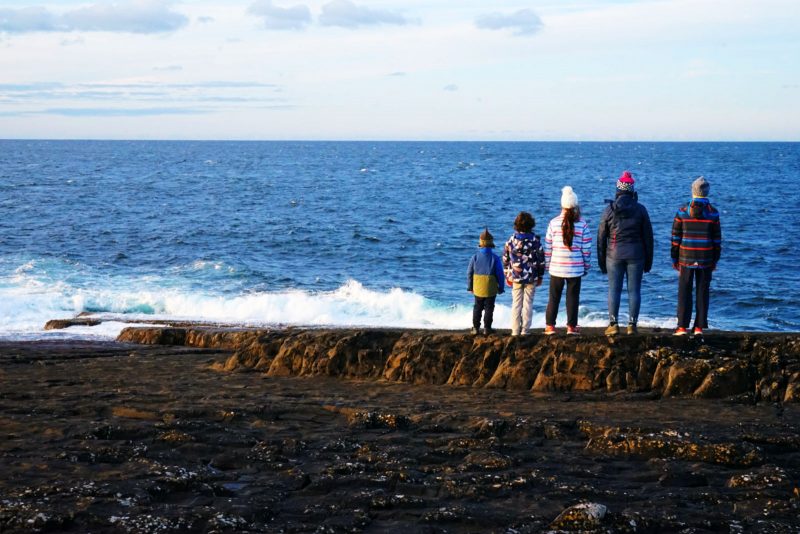
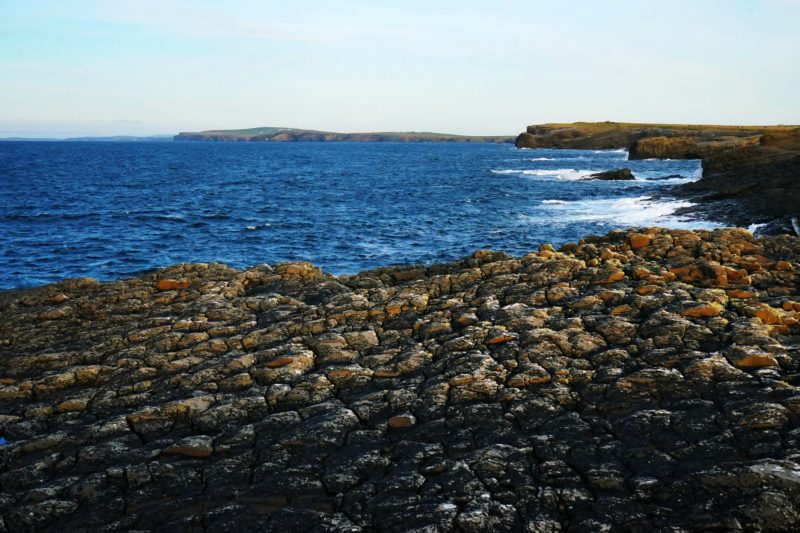
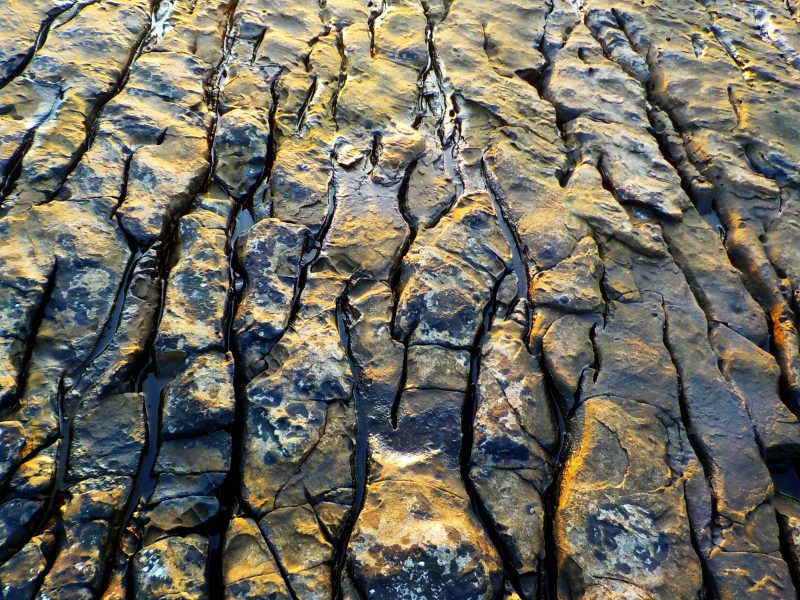
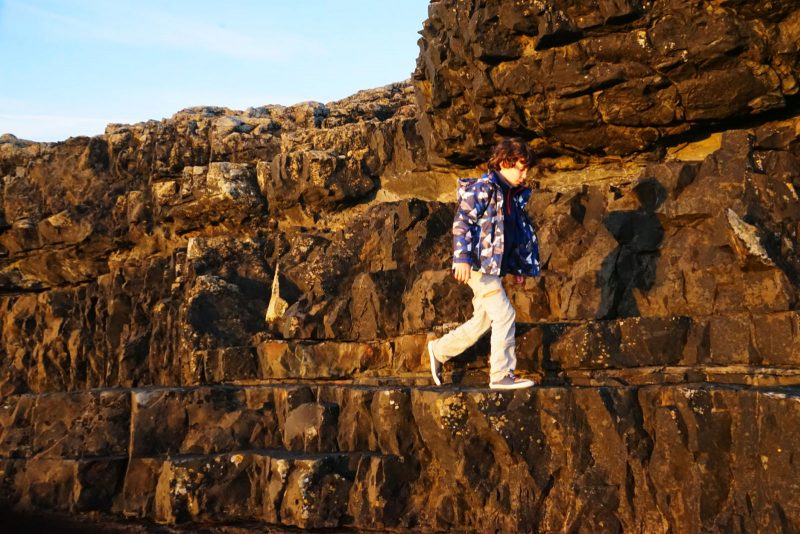
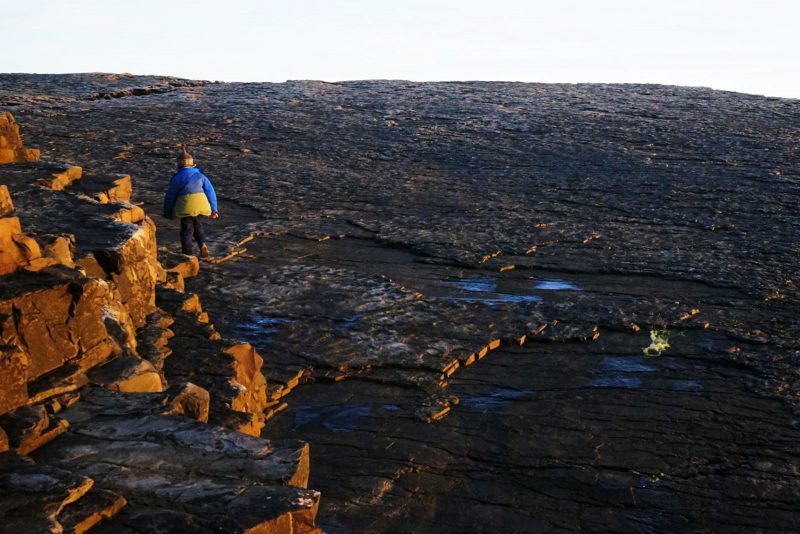
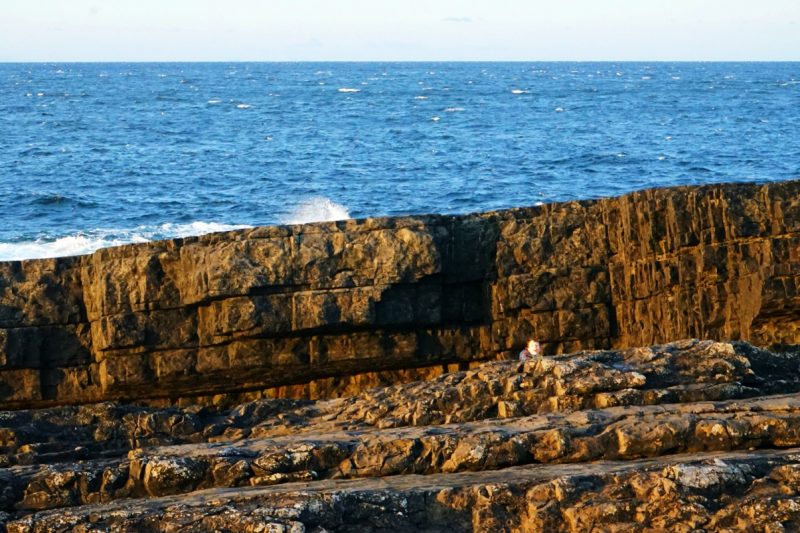
Hide-and-seek at the Bridges of Ross / Cache-cache aux ponts de Ross.
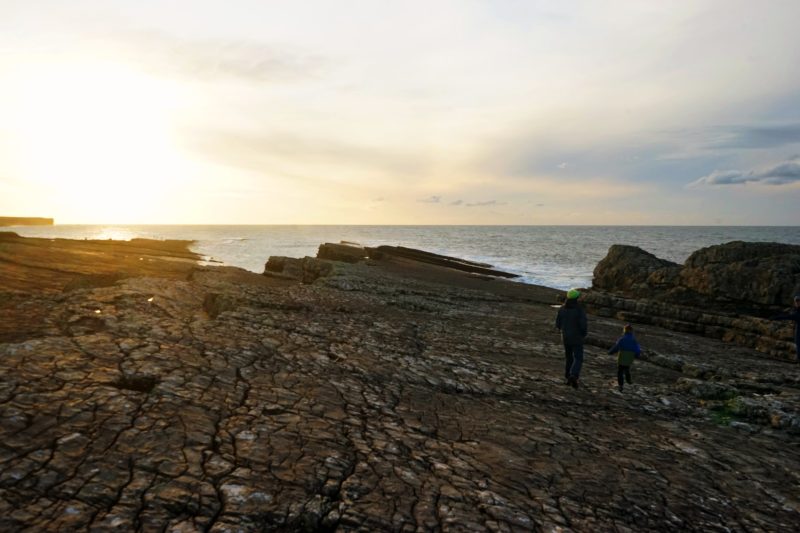
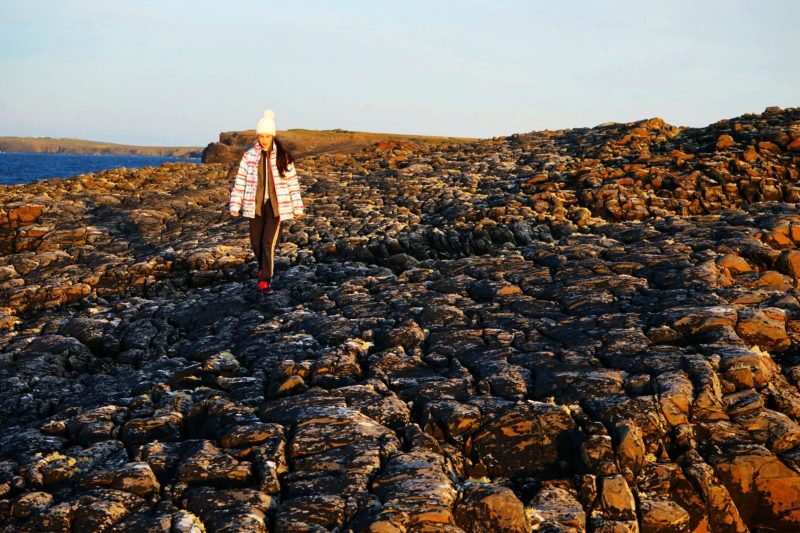
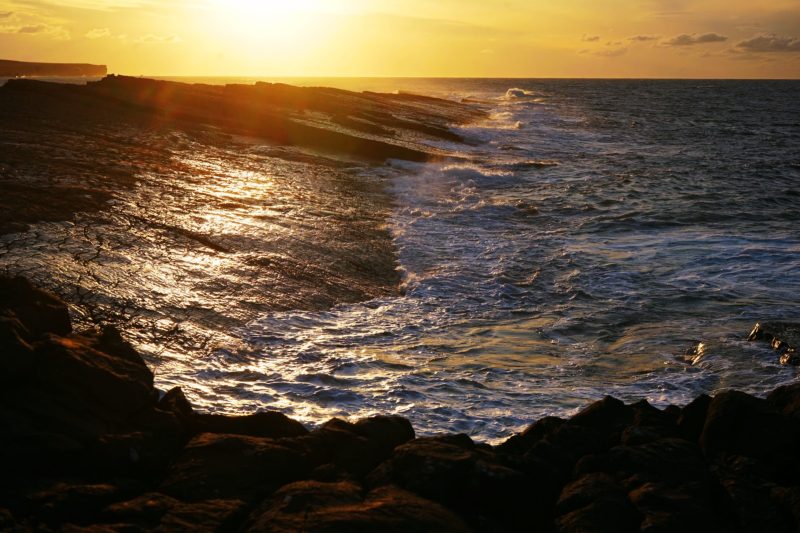
The ceaseless dance of the waves surging and crashing over the sandstone drowned our words. The hissing and buffetting of the on-shore gusts tousled our every step. The insidious cold of this early autumn dusk seeped in all the way through to our bones.
Only the balmy evening sunlight soothed the harshness of this rugged place.
La danse incessante des vagues s’écrasant sur le grès noyaient nos paroles. Le sifflement et les secousses des bourrasques marines bousculaient chacun de nos pas. Le froid sournois de ce crépuscule d’automne nous pénétrait jusqu’aux os.
Seule la douce lumière du soir atténuait quelque peu la dureté de ce lieu si rude et sauvage.
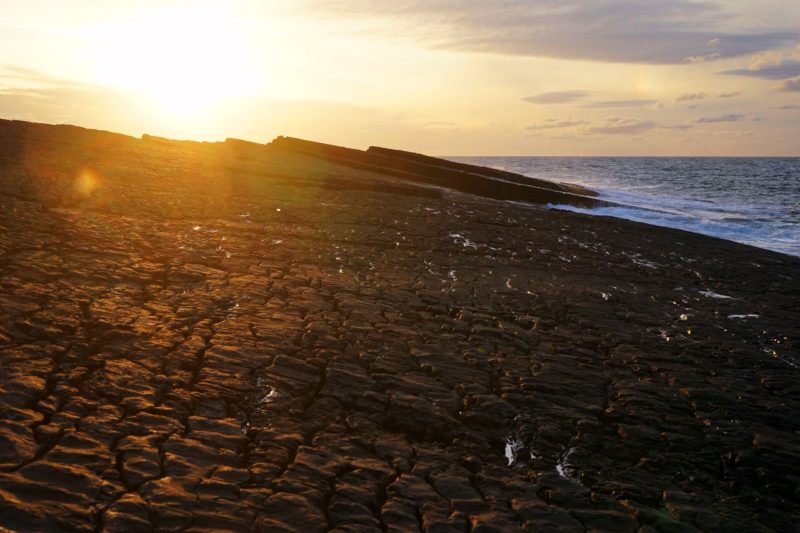
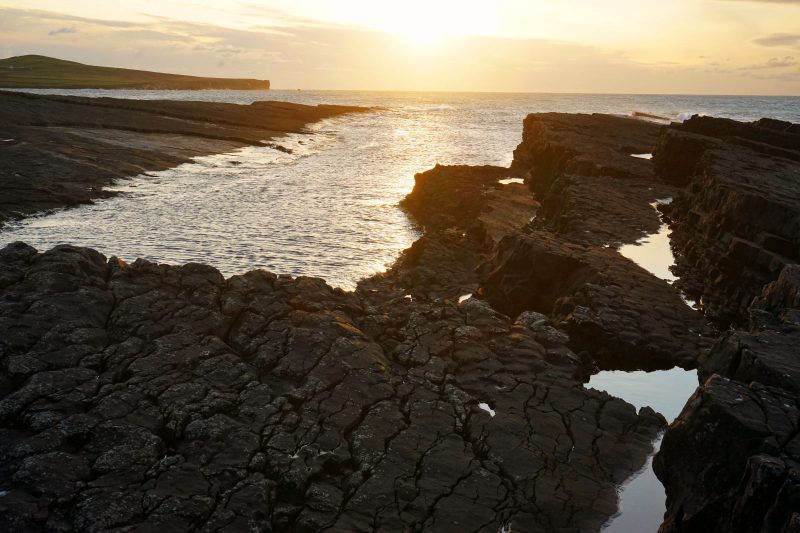
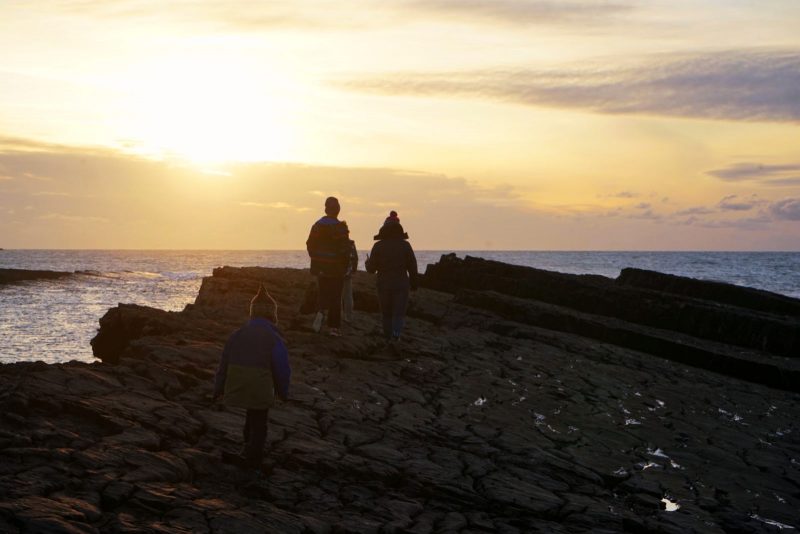
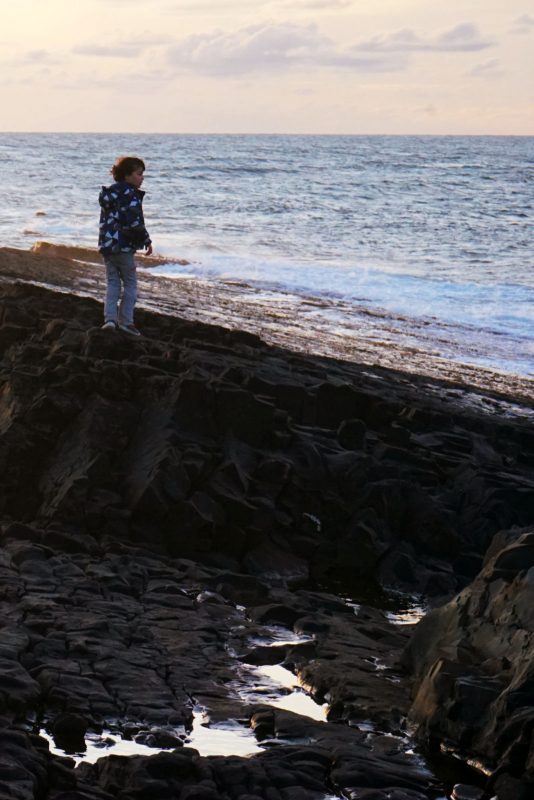
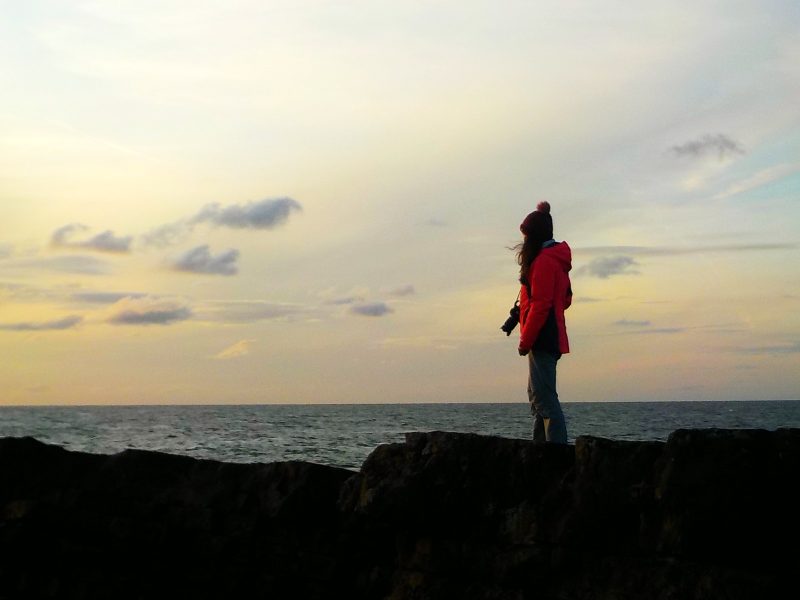
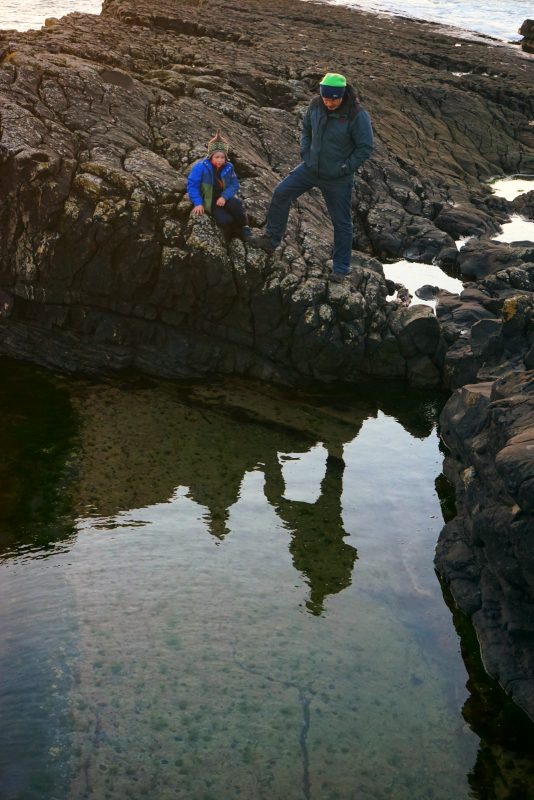
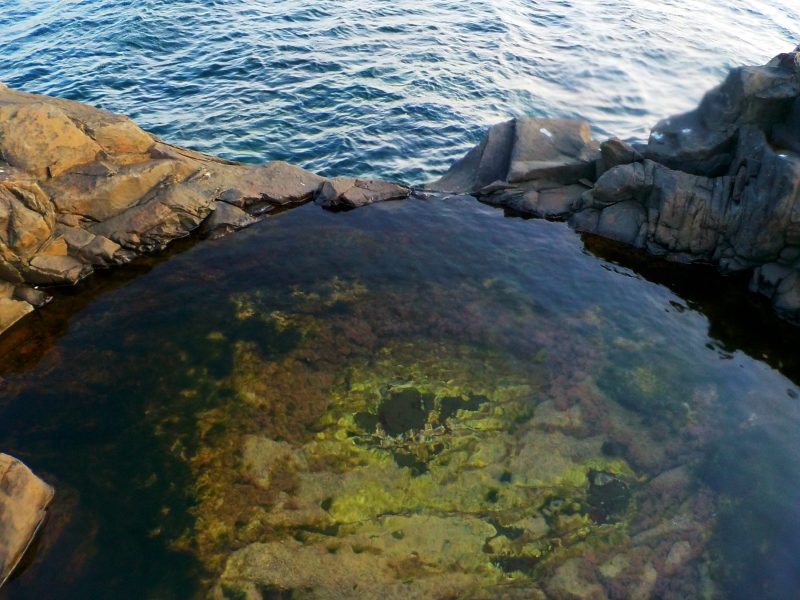
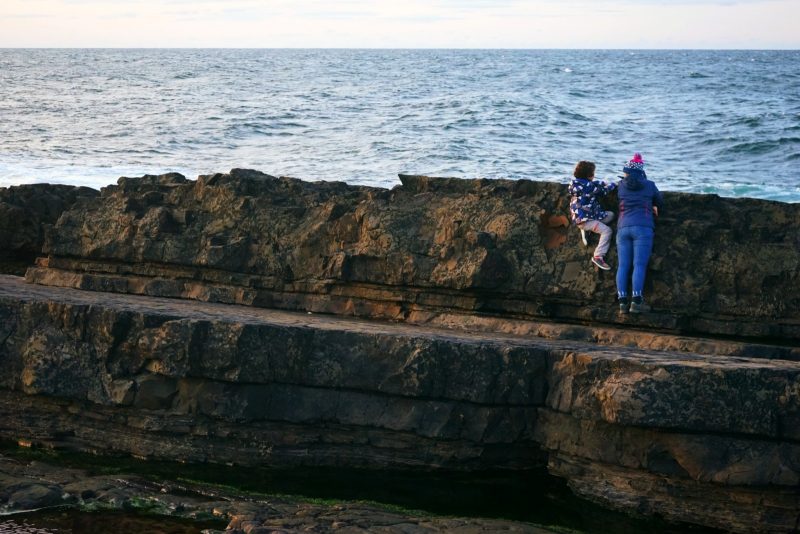
At the sea wall – between a rock and a salty place / A la digue.
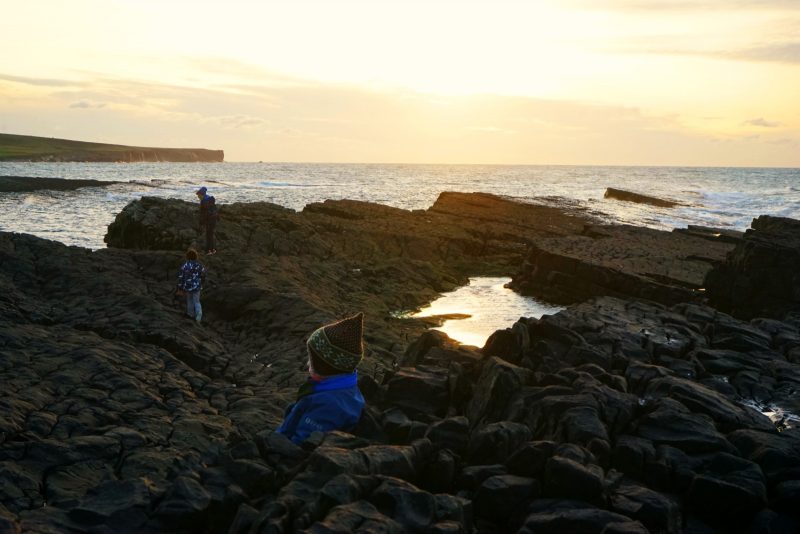
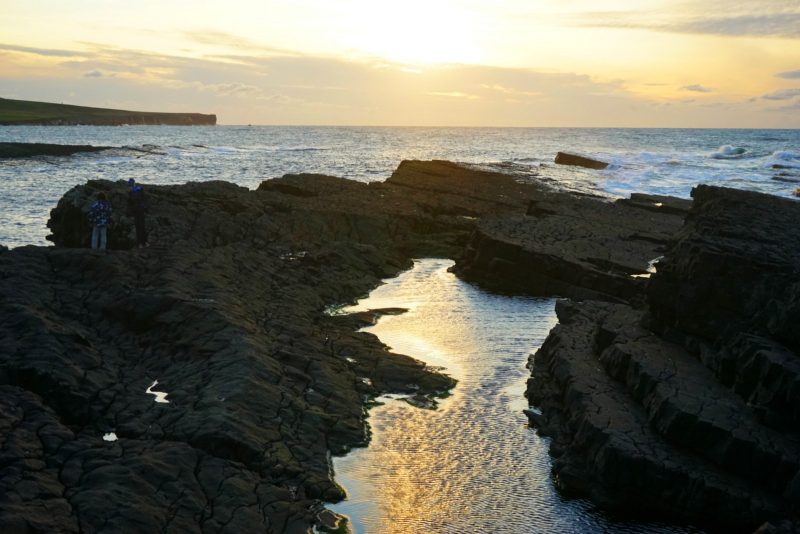
To the end of the rocky shelf / Tout au bout du plateau incliné.
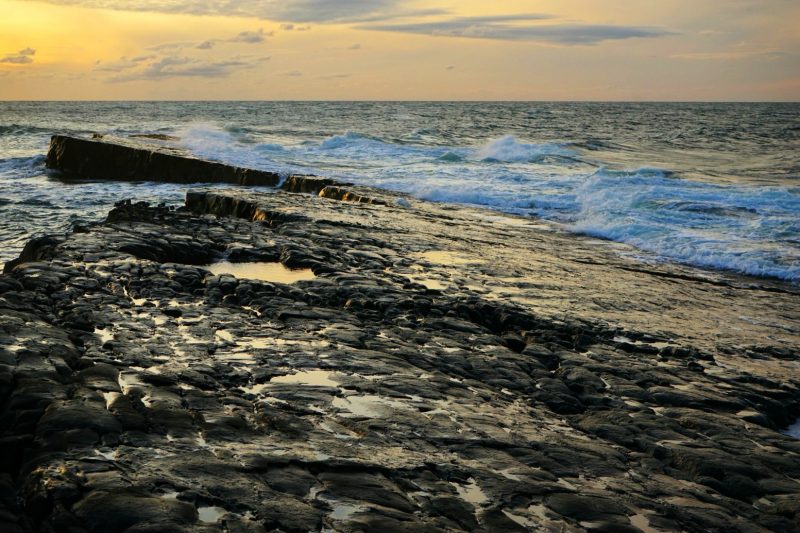
We made it to the end of the rocky shelf just as the sun set over the ocean.
The surf became more ferocious still, and we slowly retreated back to our starting point at the bridge of Ross.
Dishevelled by this wild atlantic adventure, exhilarated by the awe-inspiring power of the sea, and with salt on our lips.
Nous avons atteint l’extrémité du plateau incliné le plus long juste comme le soleil se couchait au-dessus de l’océan.
Le ressac forcit encore, alors nous avons pris le chemin du retour à notre point de départ au pont de Ross.
Ebouriffés par cette aventure atlantique, grisé par la puissance formidable de la mer, et avec un goût de sel sur les lèvres.
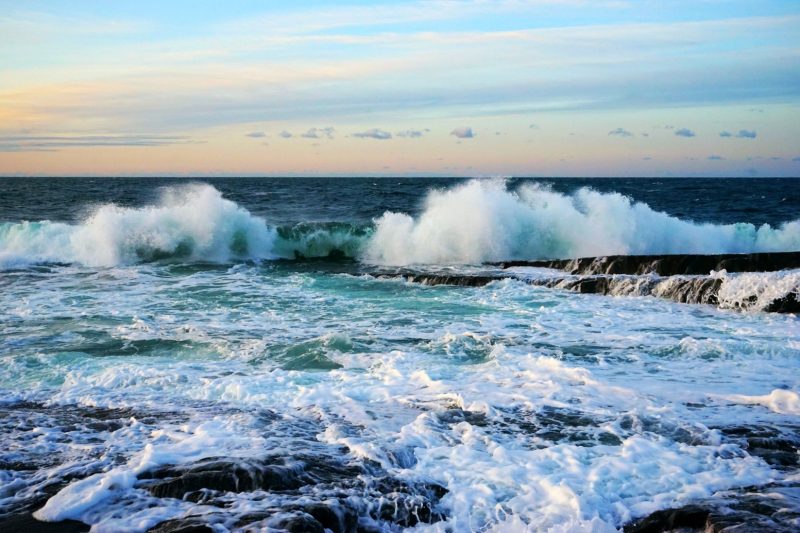
Surf’s up!
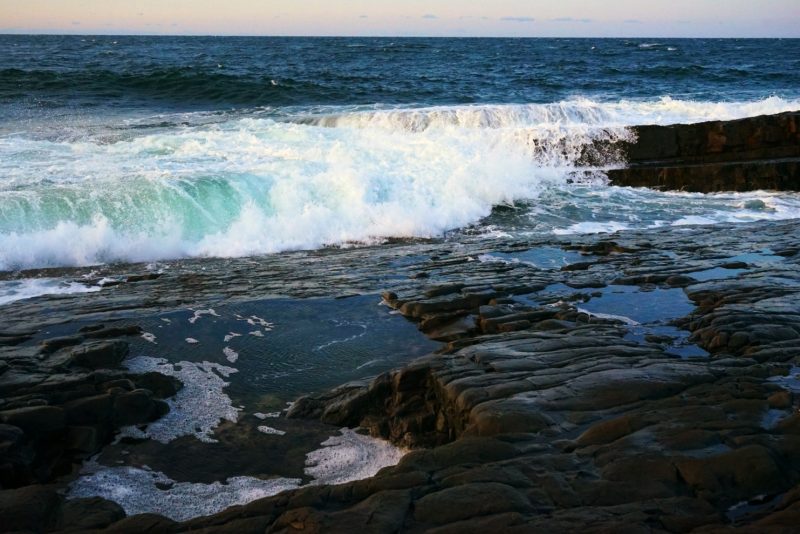
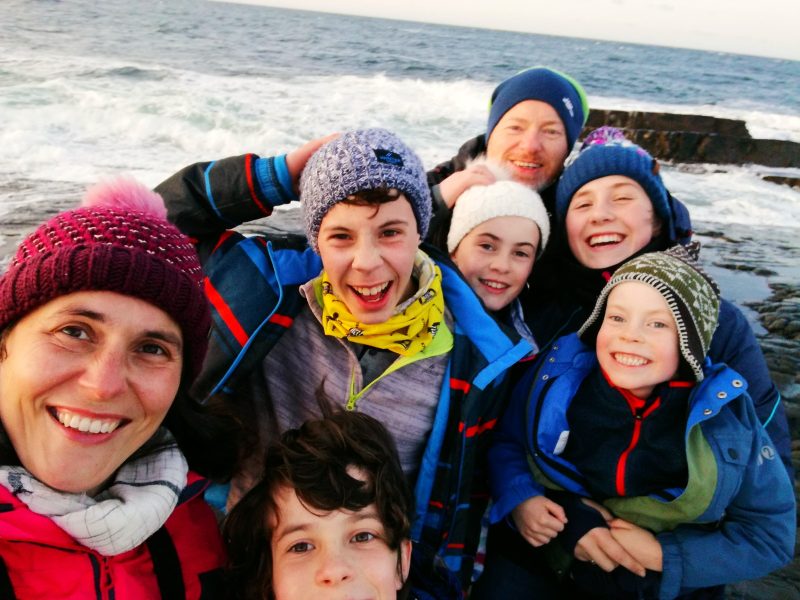
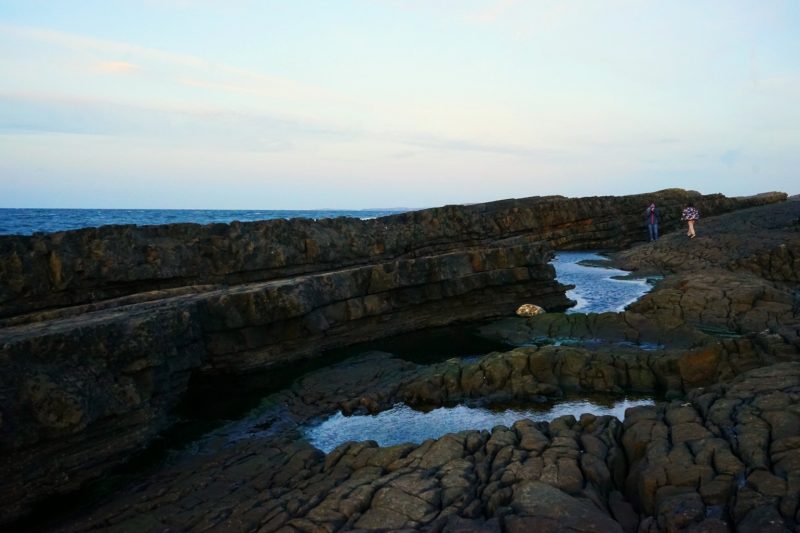
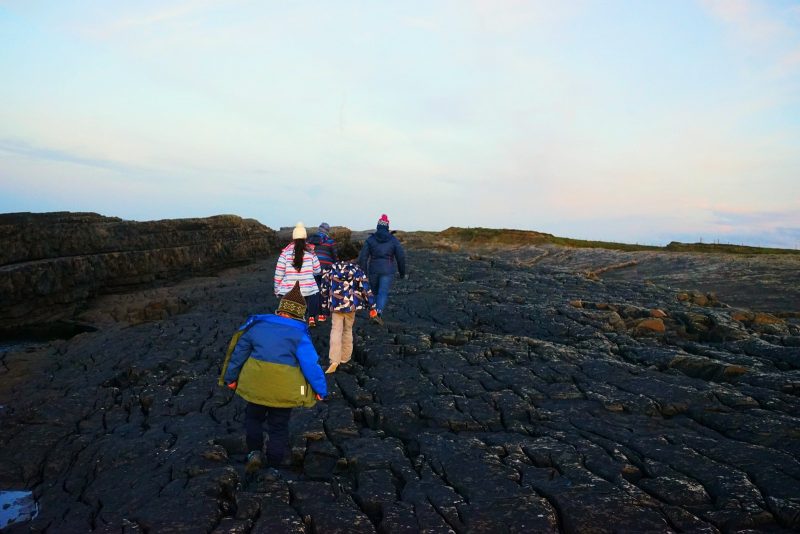
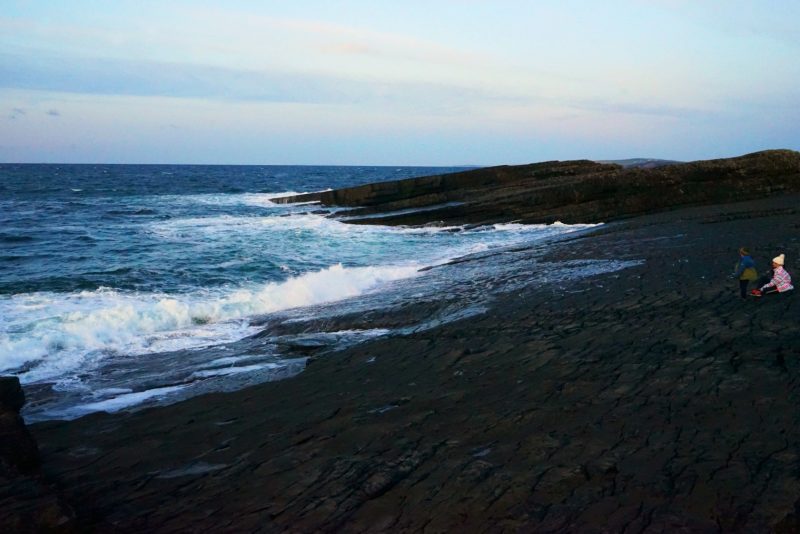
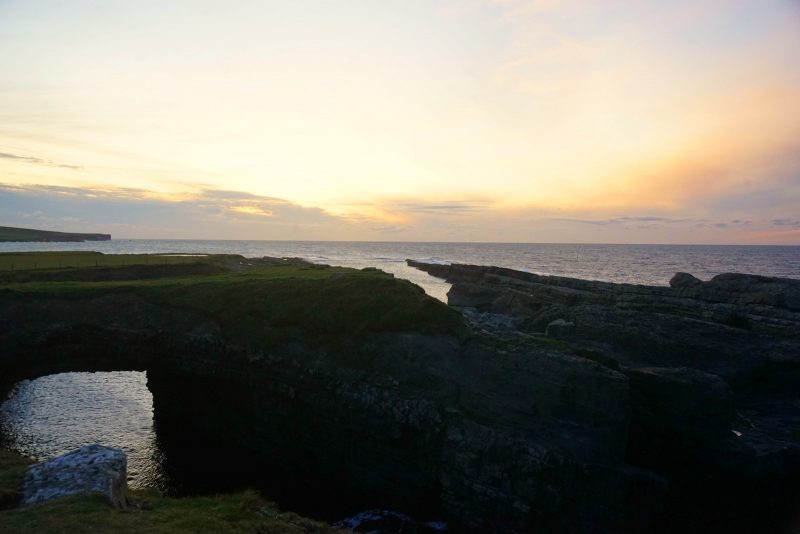
Autumn sunset at the Bridges of Ross / Crépuscule d’automne aux ponts de Ross.
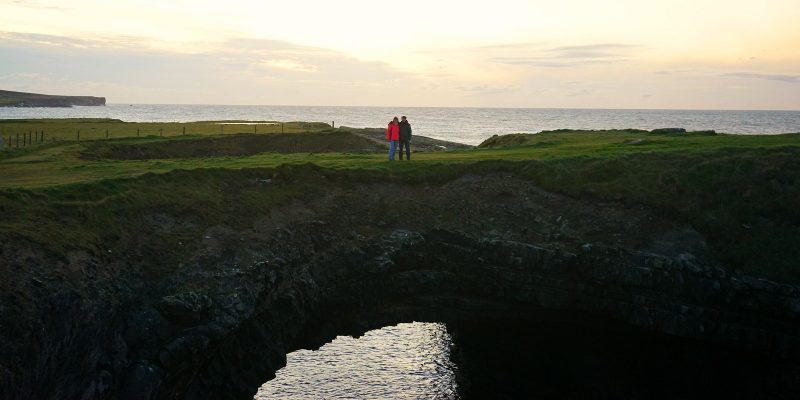
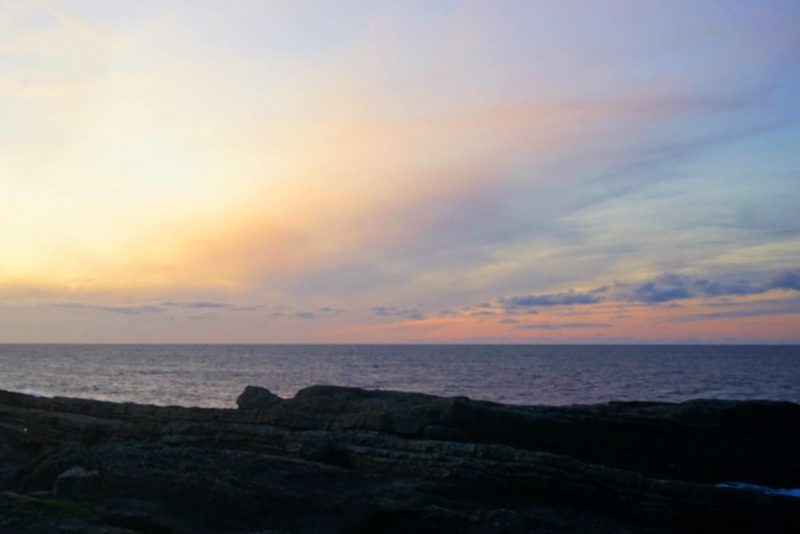
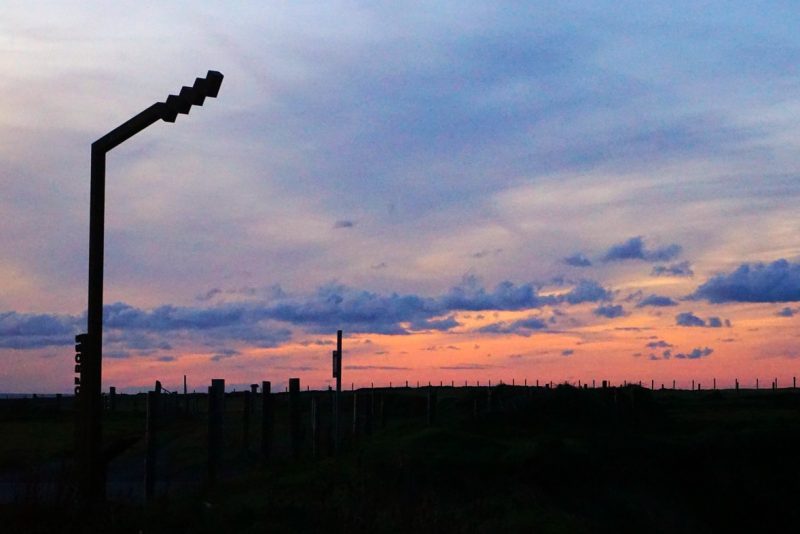
3. Dolphinwatch boat trip
Yes, you read that right! It is possible to take a dolphin watching boat trip in Ireland, and this is just what we did during our stay on the Loop Head peninsula.
I had booked this trip several weeks in advance but kept it a surprise for the acorns and P until the last minute. Geoff & Susanne Magee may have been operating Dolphinwatch Carrigaholt on the Shannon Estuary for over 25 years and won numerous responsible tourism awards for their family business. But this remains an activity that is utterly dependent on weather, tides and where dolphins are likely to be.
Susanne texted me the day before to confirm our Sunday booking, and we chose to go on the 1.30pm trip. Dressed head to toes in raingear and as many layers as possible, we boarded the Draíocht from Carrigaholt in the bright afternoon sunshine.
Les dauphins de l’estuaire de la Shannon
Eh oui, vous avez bien lu ! Il est possible de prendre un bateau en Irlande pour observer des dauphins dans leur milieu naturel. Et c’est ce que nous avons fait durant notre séjour sur la péninsule de Loop Head.
J’avais réservé auprès de Dolphinwatch Carrigaholt plusieurs semaines à l’avance, sans rien en dire aux graines de chêne jusqu’à la dernière minute. Même si Geoff et Susanne Magee opèrent sur l’estuaire de la Shannon depuis plus de 25 ans et ont remporté maints prix de tourisme responsable, cette activité dépend entièrement de la météo et des marées.
Susanne m’avait envoyé un SMS la veille pour confirmer notrre réservation du dimanche. Notre sortie était prévue à 13h30. Vêtus de la tête aux pieds de nos imperméables et d’autant d’épaisseurs que possible, nous avons embarqué du quai de Carrigaholt sous le soleil de l’après-midi.
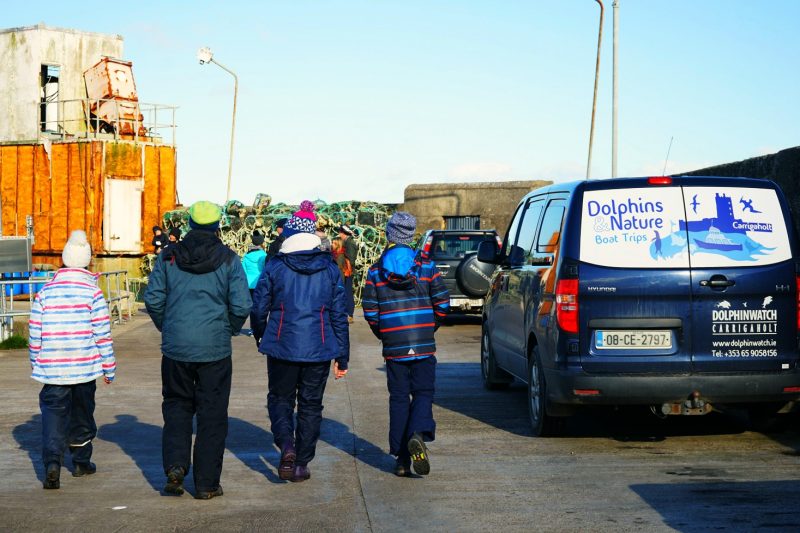
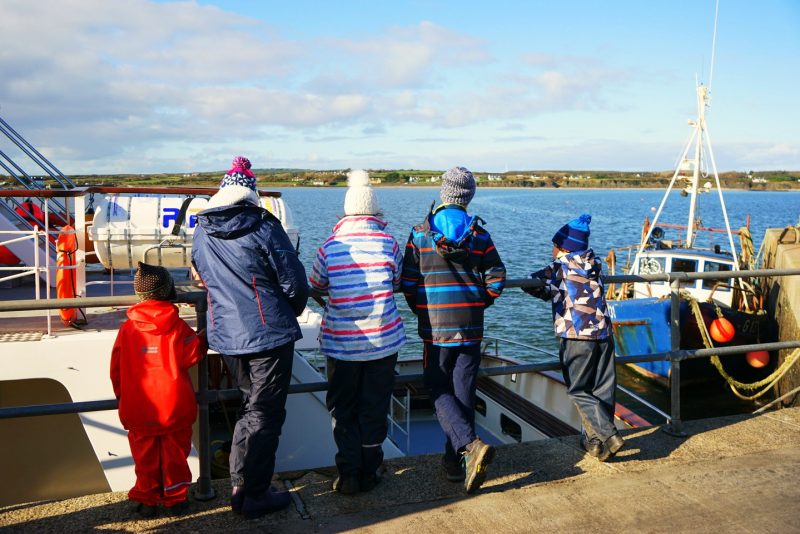
Waiting to board for our dolphin watching boat trip on the Shannon Estuary /
En attendant d’embarquer pour notre excursion dans l’estuaire de la Shannon.
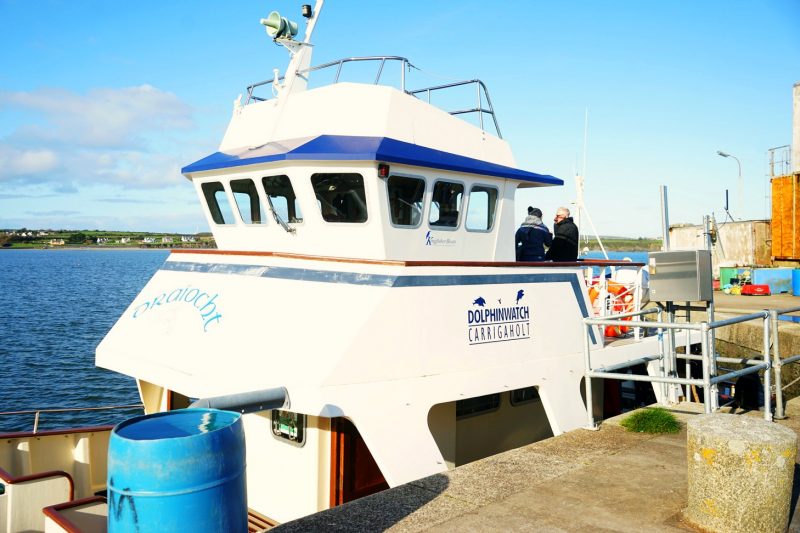
Dubbed “one of the most exciting activities and wildlife attractions on the Wild Atlantic Way“, this boat trip with Dolphinwatch Carrigaholt didn’t disappoint.
The weather was on our side, with calm waters, bright sunshine and little wind. Once we sailed past the old Kilcredaun lighthouse, it wasn’t long before our first sighting of dolphins jumping out of the water in the far distance.
Annoncée comme “une des activités les plus excitantes du Wild Atlantic Way“, l’excursion n’a pas déçu.
La météo était de la partie, avec des eaux calmes, du soleil et peu de vent. Après avoir dépassé l’ancien phare de Kilcredaun, il ne fallut guère de temps avant d’apercevoir les premiers dauphins, au loin, sauter et plonger dans les flots bleus.
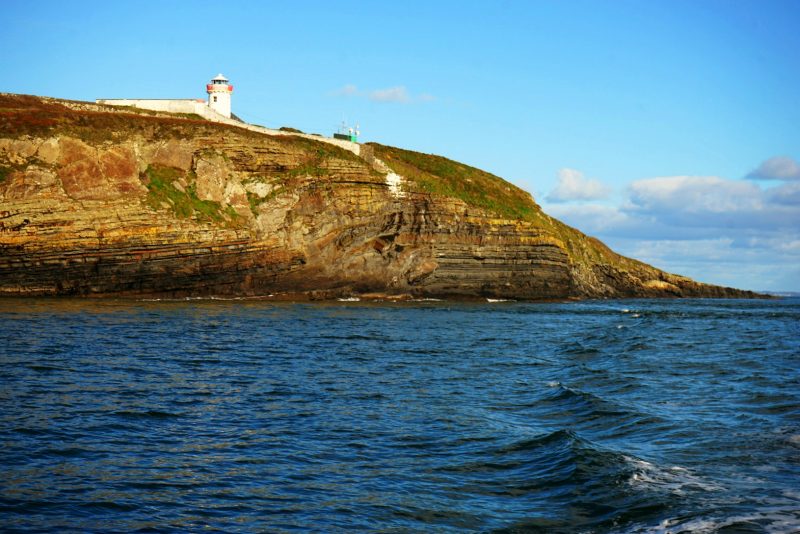
The Kilcredaun lighthouse was decommissioned in 2011 / Le phare de Kilcredaun a cessé de fonctionner en 2011.
As Geoff manoeuvred the boat to bring us closer, Susanne explained that, at this time of day, the mackerel dolphins feed on swim in the far depths of the estuary. Which meant dolphins could be diving for extended periods of time to find them. Or they could be resting after spending the previous night hunting under the cover of darkness, when the fish come closer to the surface.
The Shannon Estuary, a Special Area of Conservation (SAC) under EU law, is home to Ireland’s only known resident group of bottlenose dolphins (Tursiops truncatus), which numbers between 140-200 individuals.
When it became clear that no more dolphins would show up in this particular spot, Geoff took us further out into the estuary, to a regular feeding ground of theirs.
“Look down, they are right there, in front of the boat!”
Geoff had stepped out of his cabin to let us know.
And indeed, there were two adult dolphins swimming right in front of the boat! Or bow riding, as it’s also called. Dolphins use the bow wave of boats to swim faster while expending less energy.
We could see them just under the surface and, every so often, they jumped in an effortless splash. It is hard to convey the excitement and the awe felt at the sight of such magnificent creatures.
Comme Geoff manœuvrait le bateau pour nous approcher plus près, Susanne expliqua que, par temps ensoleillé, les maquereaux dont se nourrissent les dauphins nagent en profondeur dans l’estuaire. Si bien que les dauphins doivent plonger pendant longtemps pour les trouver. Ou alors ils se reposent après avoir chassé toute la nuit, quand leurs proies remontent plus près de la surface.
L’estuaire de la Shannon, zone spéciale de conservation (ZSC) désignée par l’Union européenne, accueille le seul groupe résident de grands dauphins (Tursiops truncatus) d’Irlande, qui compte entre 140 et 200 individus.
Quand il s’avéra que les dauphins ne voulaient plus se montrer à cet endroit spécifique, Geoff nous emmena plus en aval de l’estuaire, un de leurs lieux de nourrissage préférés.
“Regardez, ils sont juste devant le bateau !”
Geoff était sorti de sa cabine de pilotage pour nous prévenir.
Et en effet, deux dauphins adultes nageaient à la proue du bateau, profitant de la vague d’étrave pour avancer plus vite tout en dépensant moins d’énergie.
Nous les voyions clairement juste sous la surface de l’eau et, de temps à autre, ils sautaient élégamment. Difficile d’exprimer l’émerveillement ressenti à la vue de créatures aussi remarquables.
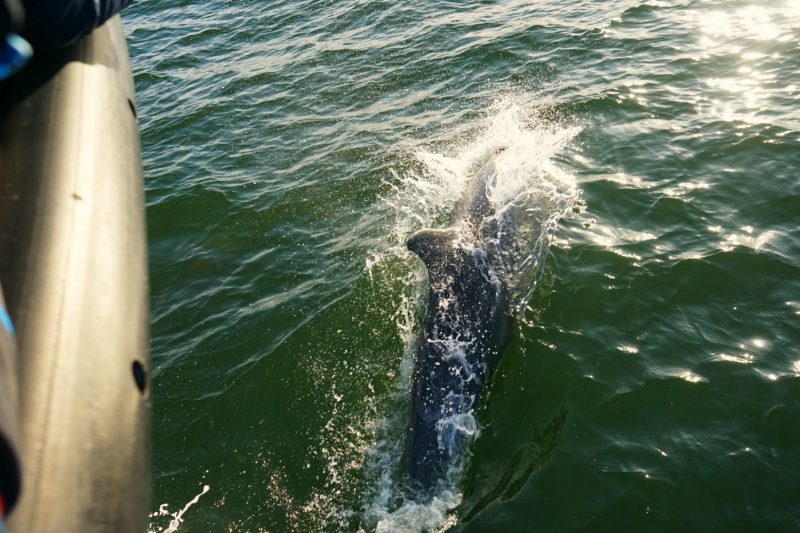
Two bottlenose dolphins swam right in front of the boat for a few minutes /
Deux grands dauphins ont nagé à l’étrave du bateau pendant quelques minutes.
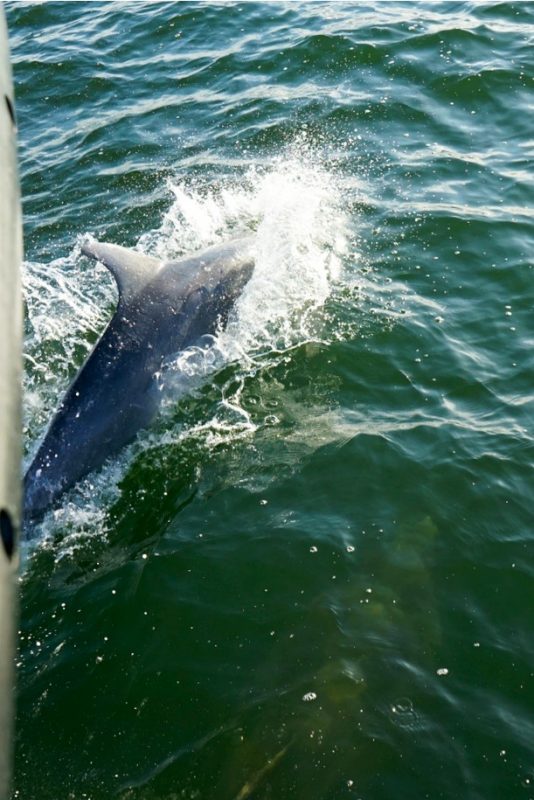
Before turning back towards Carrigaholt, the boat took us close to the spectacular Ross Sandstone Formation.
Some 320 million years ago, a huge river system carried sand and clay out to sea where it was deposited in a succession of vast sheets to form a large submarine fan delta just off the coast of the continent. These layers of sedimentary rocks, eroded and exposed by rising and falling sea levels over millenia, bear witness to the rich geological heritage of Loop Head.
Avant de repartir pour Carrigaholt, le bateau nous approcha de l’étonnante formation de grès de Ross.
Il y a quelque 320 millions d’années, un énorme bassin hydrographique charriait sable et argiles, déposant en mer une succession d’immenses couches rocheuses. Ces dernières finirent par former un vaste delta sous-marin au large du continent. Ces roches sédimentaires, érodées et exposées par la montée et la descente du niveau des mers pendant des millénaires, témoignent du riche patrimoine géologique de Loop Head.
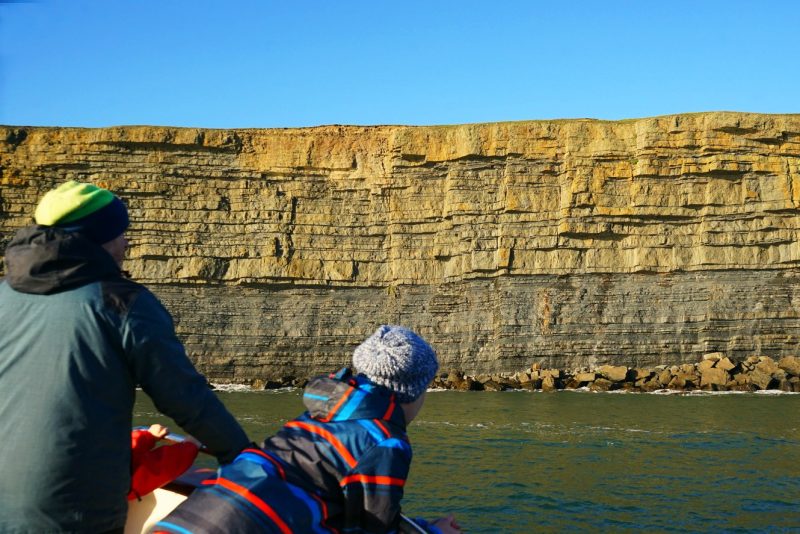
The Ross Sandstone Formation viewed from the sea / La formation de grès de Ross vue de la mer.
Further along the coast, the waves have sculpted nooks and arches in which currents rush and swoop and erupt geyser-like, or like a whale spouting out of its blowhole.
Plus loin, les vagues ont sculpté maintes arches et cavités dans lesquelles les courants se précipitent et tourbillonnent et explosent comme des geysers, ou comme une baleine expirant par son évent.
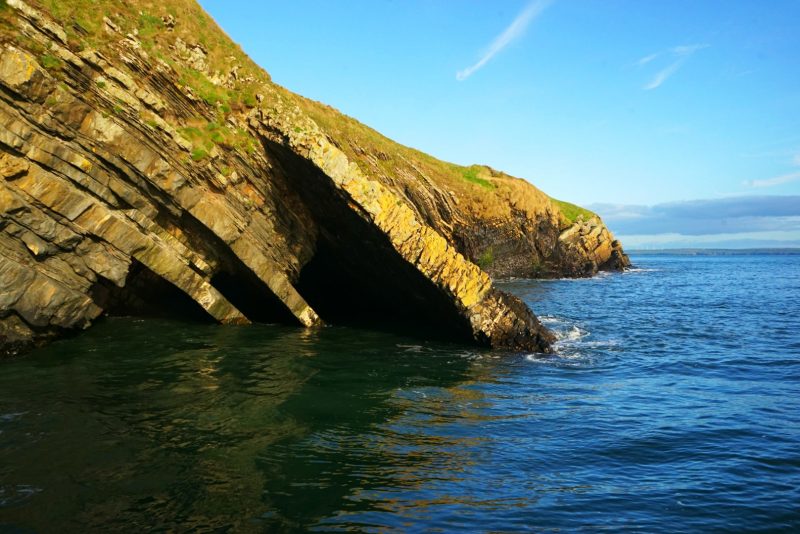
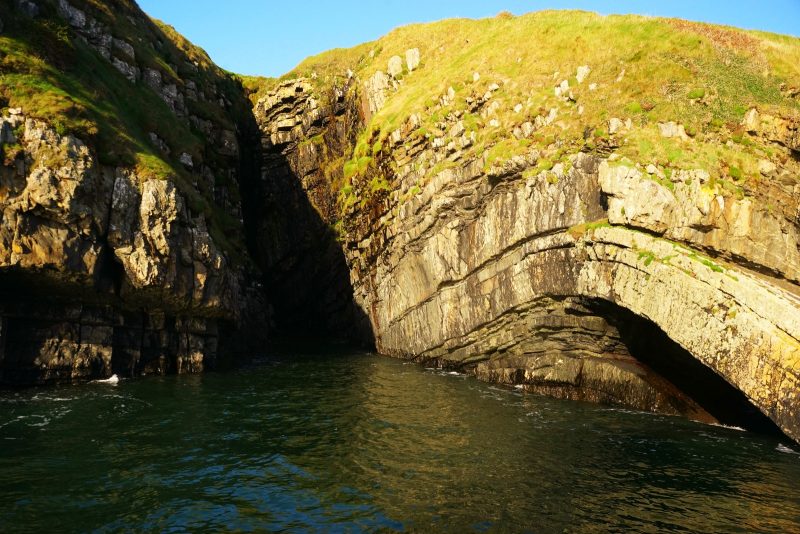
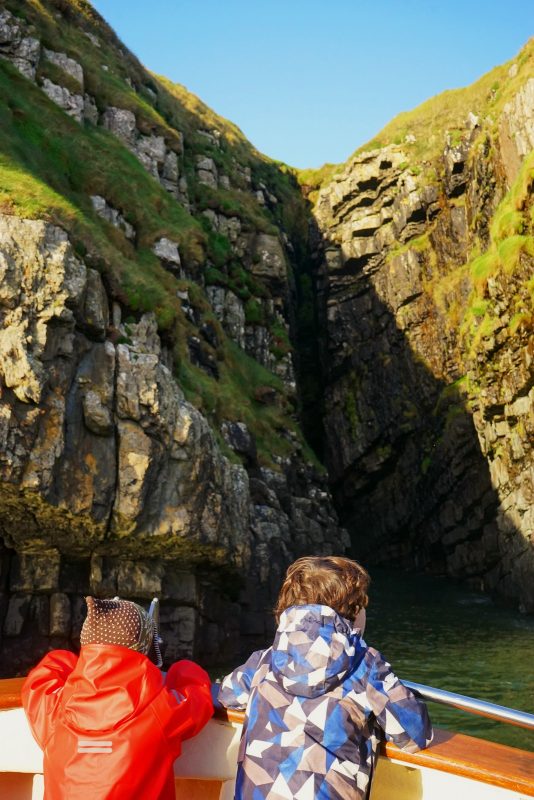
Finally, as the sun got lower on the Shannon Estuary and the wind grew colder, we made our way back to Carrigaholt. The end of a fine day on Loop Head’s Wild Atlantic Way.
Enfin, comme le soleil baissait sur l’estuaire de la Shannon et que le vent se refroidissait, nous sommes repartis vers Carrigaholt. Une belle journée s’achevait sur le Wild Atlantic Way de Loop Head.
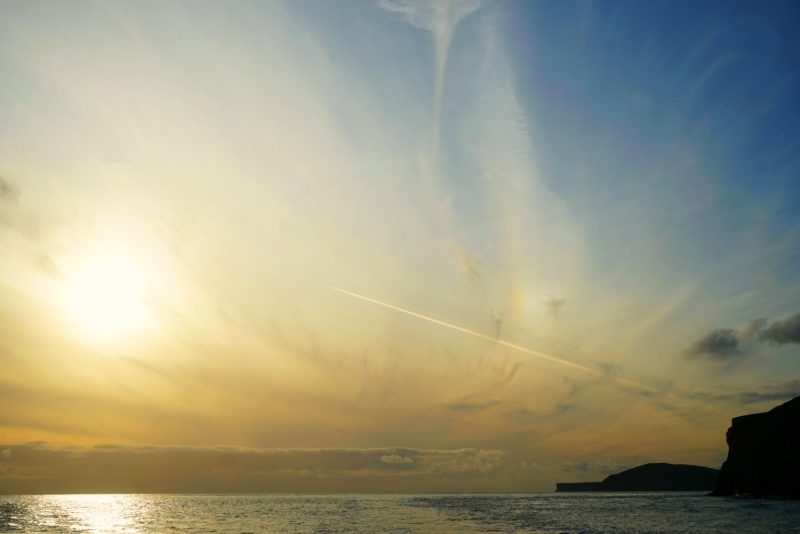
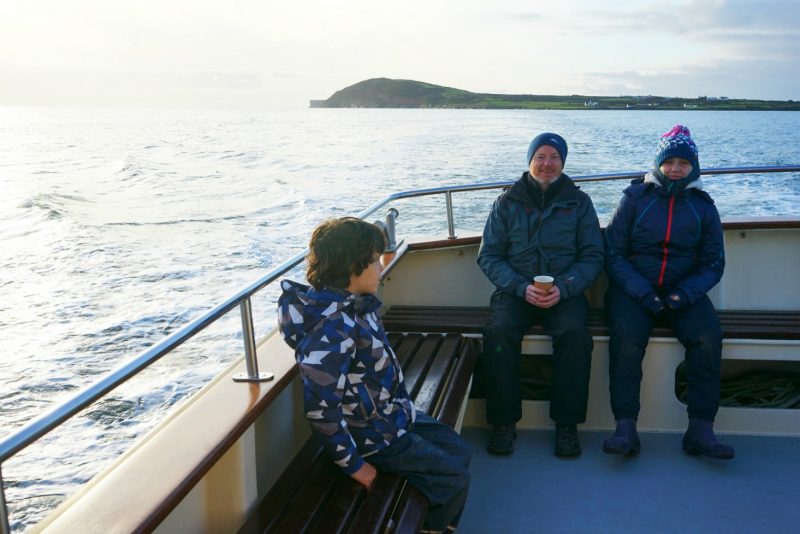
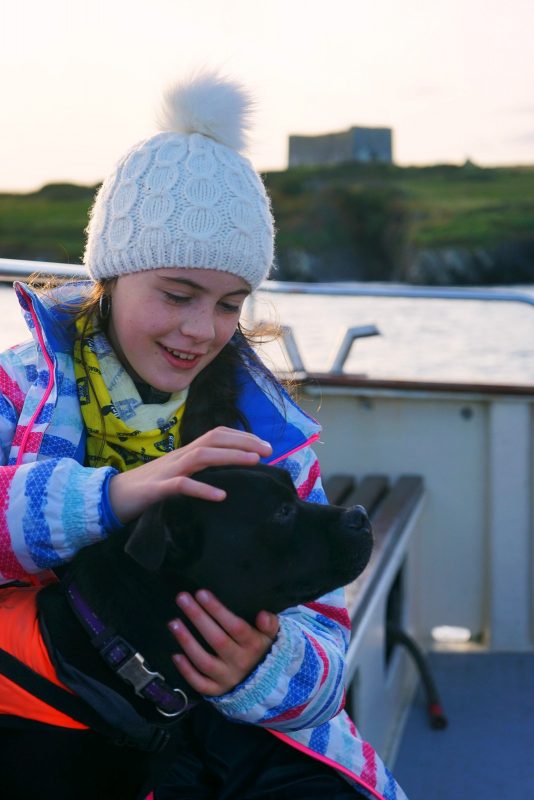
Milly is a fully-fledged crew member of Dolphinwatch /
Le chien Milly est un membre d’équipage à part entière.
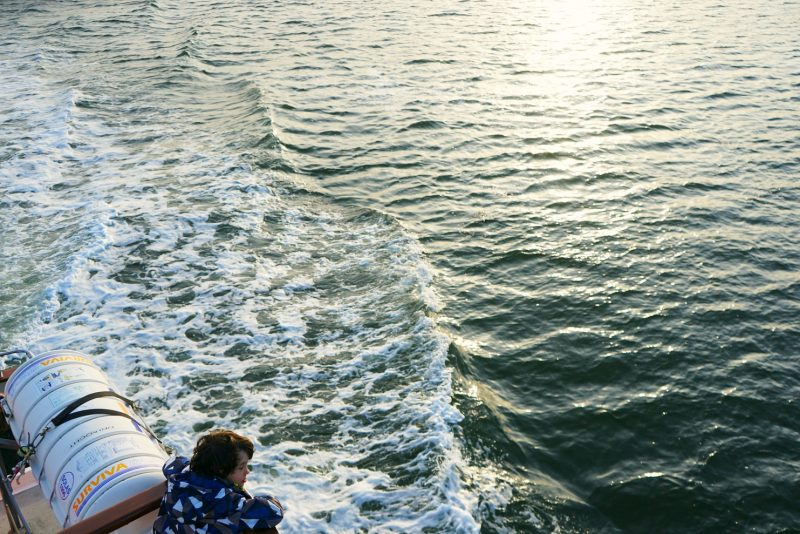
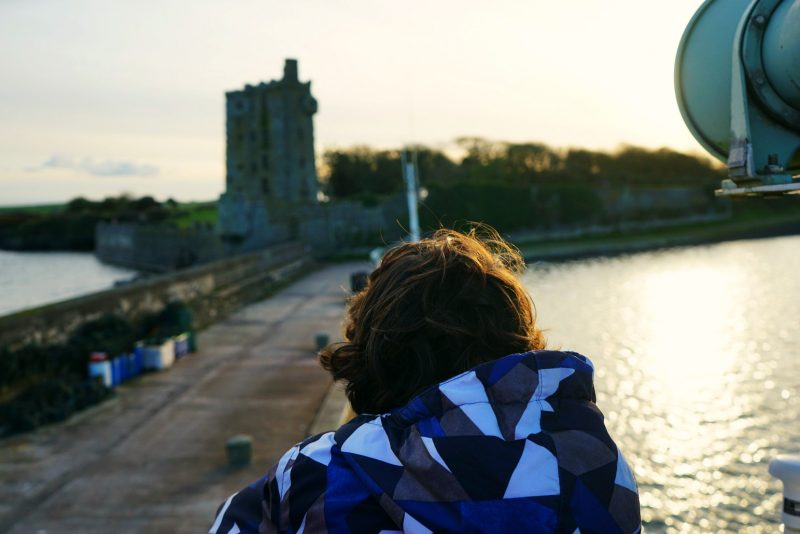
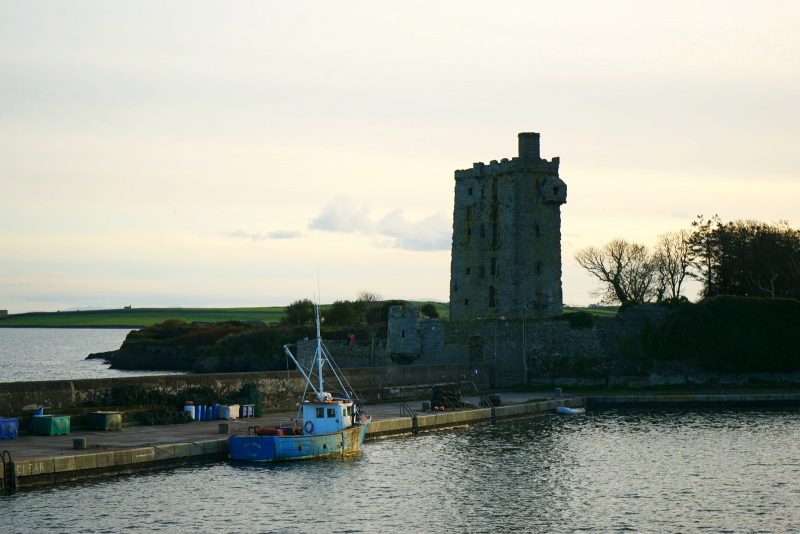
Carrigaholt harbour and castle / Le port et le château de Carrigaholt.
The Pollock Holes
If the highlight of our weekend on Loop Head was the dolphin-watching boat trip for the acorns and P, mine was undoubtedly swimming in the Pollock Holes.
Those rockpools in the Duggarna Reef, on the edge of Kilkee, were the reason for booking a weekend away on the Loop Head peninsula. And they turned out to be even more magical than expected!
Read all about this wild Atlantic adventure in a separate post here!
Si la sortie pour observer les dauphins a été le temps fort de notre weekend à Loop Head pour les graines de chêne et P, le mien a été sans aucun doute notre baignade dans les bassins de marée de Kilkee, ou Pollock Holes.
Ces piscines naturelles d’eau de mer étaient la principale motivation derrière ce weekend sur la péninsule de Loop Head. Et ils ont dépassé toutes mes attentes !
Découvrez cette incroyable aventure atlantique dans un article à part ici !
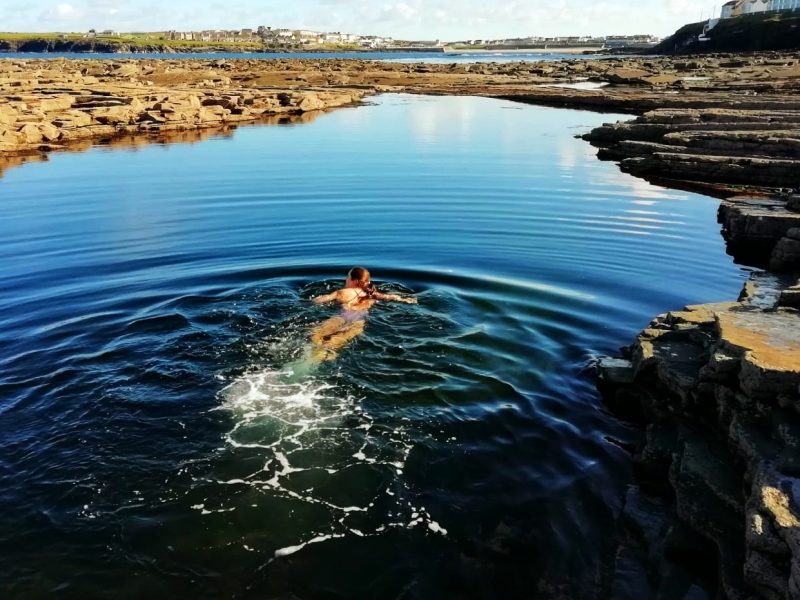
Loop Head visitor information
 Loop Head is a slender finger of land pointing out to sea from the most westerly point of County Clare, on the Wild Atlantic Way, between the ocean on one side and the Shannon Estuary on the other.
Loop Head is a slender finger of land pointing out to sea from the most westerly point of County Clare, on the Wild Atlantic Way, between the ocean on one side and the Shannon Estuary on the other.
In 2010, Loop Head became a European Destination of Excellence in aquatic tourism. In 2013, it was voted the Best Place to Holiday in Ireland by The Irish Times. In 2014, it made it into the top 100 Global Sustainable Destinations.
“Loop Head Tourism is committed to promoting responsible and sustainable tourism development while safeguarding the unique culture, heritage and biodiversity of the peninsula through co-operation with all stakeholders in the wider community.”
We booked our self-catering holiday accommodation at Anvil Farm through WestClare.net, which is part of Places To Stay in Ireland, a network of private Irish holiday accommodation providers.
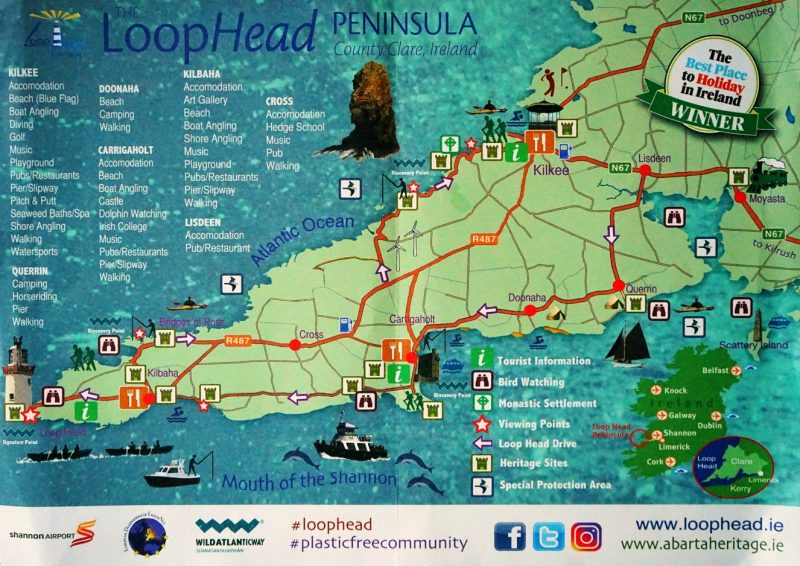
Dolphinwatch Carrigaholt
 The Square
The Square
Carrigaholt
Co Clare
V15 YW64
Tel. +353 (0)659058156
Email info@dolphinwatch.ie
Geoff & Susanne Magee started Dolphinwatch Carrigaholt in 1992 and love taking people out on the amazing Mouth of the Shannon with its resident group of bottlenose dolphins, thousands of nesting pelagic seabirds, seals, fascinating geology, cliffs and caves.
Prices for the Dolphin & Nature Boat Trip, which we did, are as follows: €35 adult; €20 child (2-14 yo). Please note that, as the boat trips are weather and tide dependent, you will receive an SMS before 9am on the day of sailing to confirm your booking. No money will be charged at the time of reservation. All details and booking conditions are available here.
Dress warmly, with waterproofs on top to act as windbreak, whatever the season.
 An autumn holiday along the Wild Atlantic Way may not seem an obvious option, but this article offers many inspiring ideas to make the most of it.
An autumn holiday along the Wild Atlantic Way may not seem an obvious option, but this article offers many inspiring ideas to make the most of it.
Renseignements pratiques
Loop Head est une langue de terre étroite qui s’avance dans l’océan au point le plus occidental du comté de Clare, sur le Wild Atlantic Way, entre l’Atlantique d’un côté et l’estuaire de la Shannon de l’autre.
En 2010, Loop Head a été nommé Destination européenne d’excellence en tourisme aquatique. En 2013, la péninsule a été nommée Meilleure Destination de vacances en Irlande par le quaotidien The Irish Times. En 2014, elle a fait son entrée parmi les 100 destinations mondiales de tourisme responsable.
“Loop Head Tourism s’engage à promouvoir un développement touristique responsable et durable tout en préservant la culture, le patrimoine et la biodiversité uniques à la péninsule en coopérant avec tous les acteurs de la communauté.”
Nous avons réservé notre location de vacances à Anvil Farm par le biais de WestClare.net, qui fait partie du réseau irlandais de loueurs particuliers Places To Stay in Ireland.
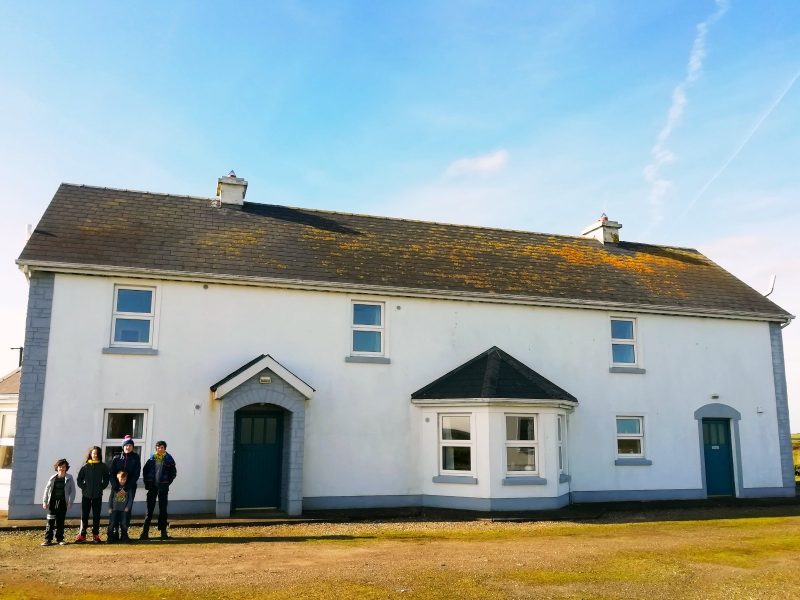
Anvil Farm, Kilbaha, Loop Head, Co Clare
Dolphinwatch Carrigaholt
 The Square
The Square
Carrigaholt
Co Clare
V15 YW64
Tel. +353 (0)659058156
Email info@dolphinwatch.ie
Geoff et Susanne Magee ont lancé Dolphinwatch Carrigaholt en 1992 pour emmener les visiteurs à la découverte de la faune extraordinaire de l’estuaire de la Shannon, des grands dauphins aux phoques et aux milliers d’oiseaux de mer qui viennent y nicher, sans parler de la géologie fascinante de la région, avec ses falaises et ses grottes.
Les tarifs pour l’excursion Dolphins & Nature, que nous avons faite, sont de 35 € par adulte et 20 € par enfant (2-14 ans). A noter que, comme les sorties en bateau dépendent des conditions de navigation (marées et météo), vous recevrez un SMS à 9 heures au plus tard le jour de la sortie pour confirmer votre réservation. Le règlement s’effectue à bord du bateau, et non pas au moment de la réservation. Détails et conditions de vente sont disponibles ici.
Prévoyez des vêtements chauds et imperméables, quelle que soit la saison.

Related / Similaire
- Salty adventures at the Pollock Holes / Aventures salées aux Pollock Holes
- Starlight kayaking on Lough Hyne / Une escapade en kayak sous les étoiles
- A secret beach and a wild Atlantic swim / Plage secrète et baignade sauvage dans l’Atlantique
- Wild Atlantic Achill / Achill l’Atlantique
- Like a bird on the Saltee Islands / Comme un oiseau sur les îles Saltee
- 10 stunning Irish beache / 10 plages d’Irlande à couper le souffle
Disclosure:
This is NOT a sponsored post. I received no compensation from Loop Head Tourism or Dolphinwatch Carrigaholt, to write it.
This post contains some affiliate links. Should you choose to make a purchase after clicking on one of them, I may receive a small commission and your purchase will help support this site.
Divulgation :
Ceci n’est pas un article sponsorisé. Je n’ai reçu aucune compensation de Loop Head Tourism ou Dolphinwatch Carrigaholt en échange de sa rédaction.
En revanche, cet article contient des liens partenaires. Si vous décidez d’effectuer un achat après avoir cliqué sur l’un d’eux, je recevrai une commission qui contribuera à soutenir ce site.









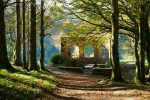 Previous Post
Previous Post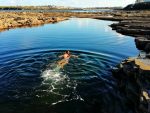 Next Post
Next Post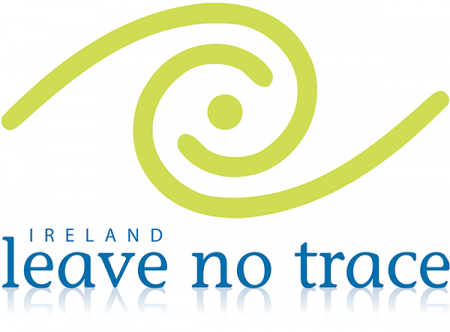
Oh I love lighthouses – this looks and sounds amazing, would love to go kayaking around there, should put it on the list 🙂
Wow what an amazing location for some stunning family photos. Those cliffs and the drops are quite something. Looks like some amazing weather for you and wow to seeing the dolphins from the boat. Some very brave swimmers in your party. #CountryKids
It’s just so WILD on that coast, isn’t it? I imagine it’s just so thrilling standing on the cliffs and watching the waves crash onto the shore. Combine that with the great walks and the dolphin watching and it’s got to be one of the best half terms ever, I’d say! Thanks for sharing on #farawayfiles
What a beautiful place to explore – that coastline is just stunning. Loop Head lighthouse sounds like an interesting place to visit and I love the first photo of it. Sitting and watching the sun set over the Atlantic sounds absolutely idyllic. Looks like your acorns had a lot of fun exploring the Bridges of Ross especially with all the sea foam. How amazing to go dolphin watching too and seeing those dolphins swimming so close to your boat is just magical. Glad you enjoyed your wild swim in the Pollock Holes as well. Thanks for sharing with #CountryKids
What a stunning area to explore. We love lighthouses and the history of them and seeing dolphins swimming is a magical experience isn’t it #countrykids